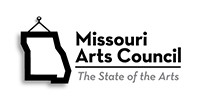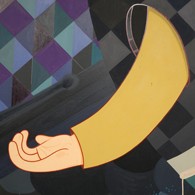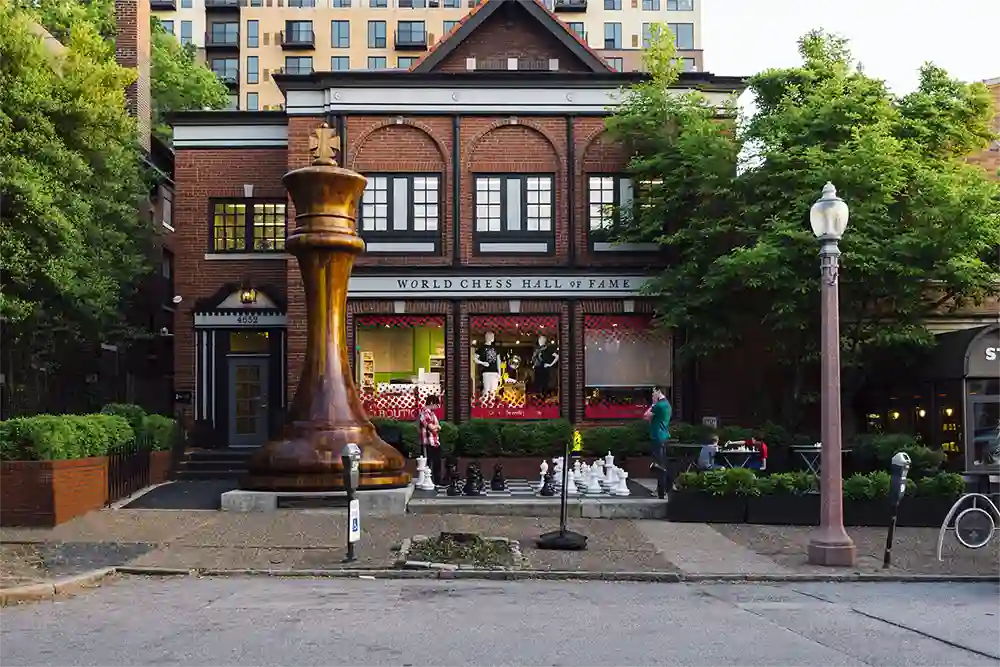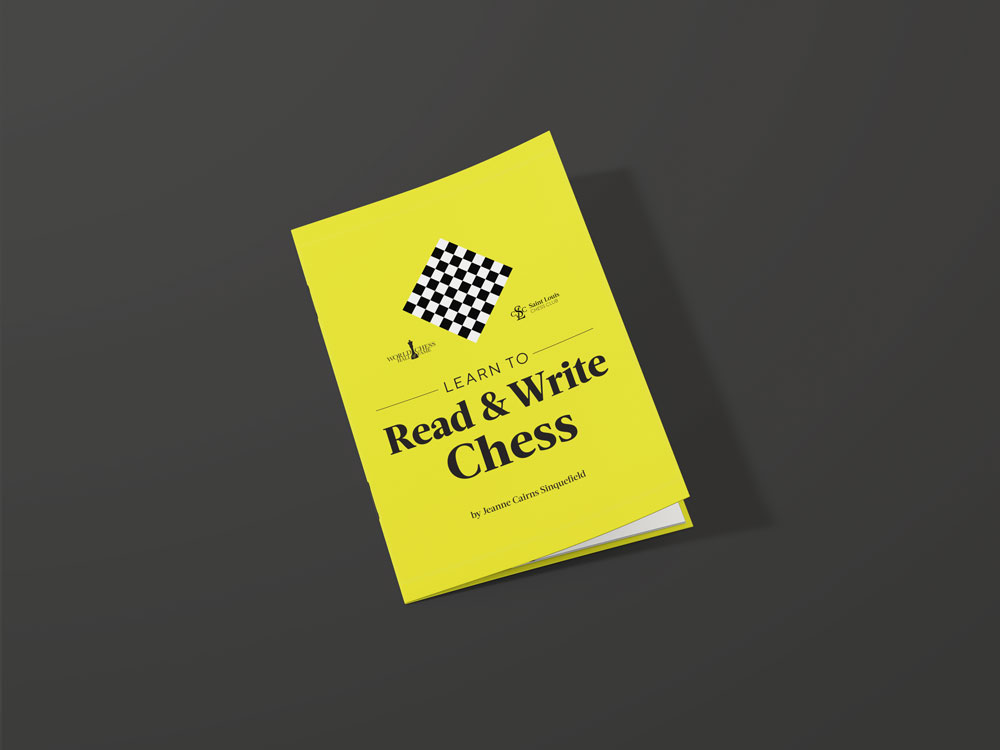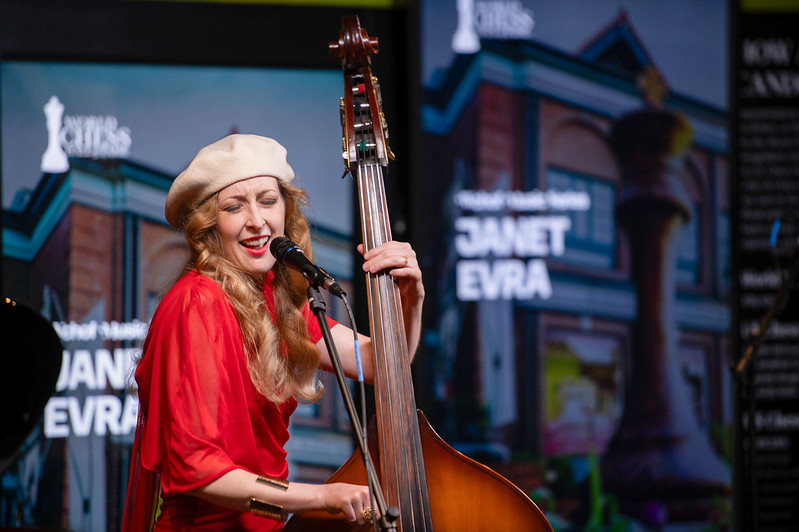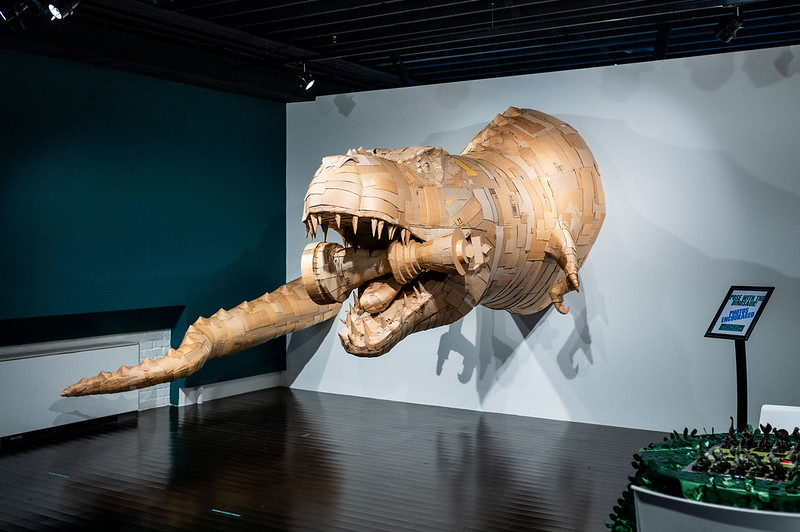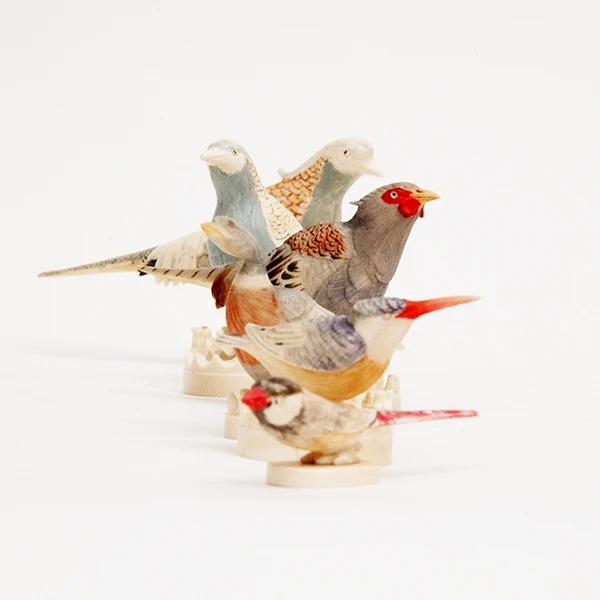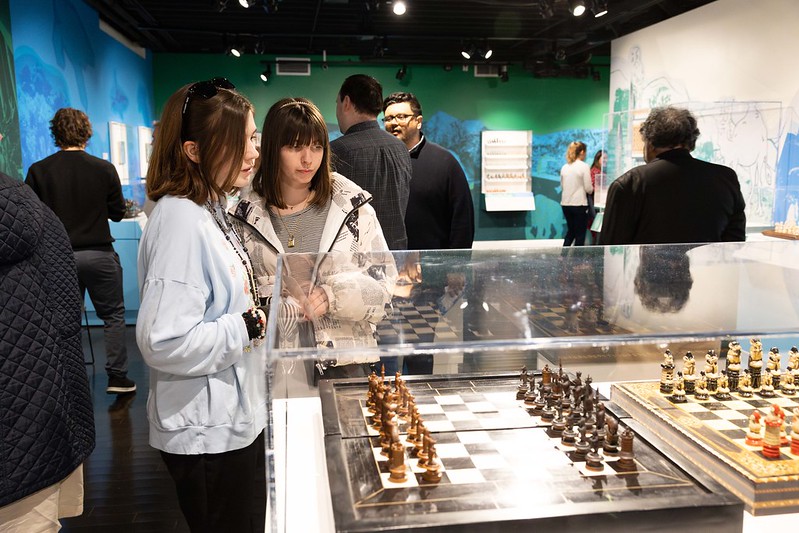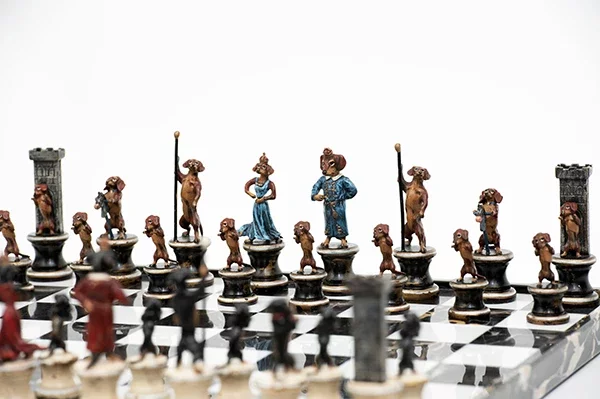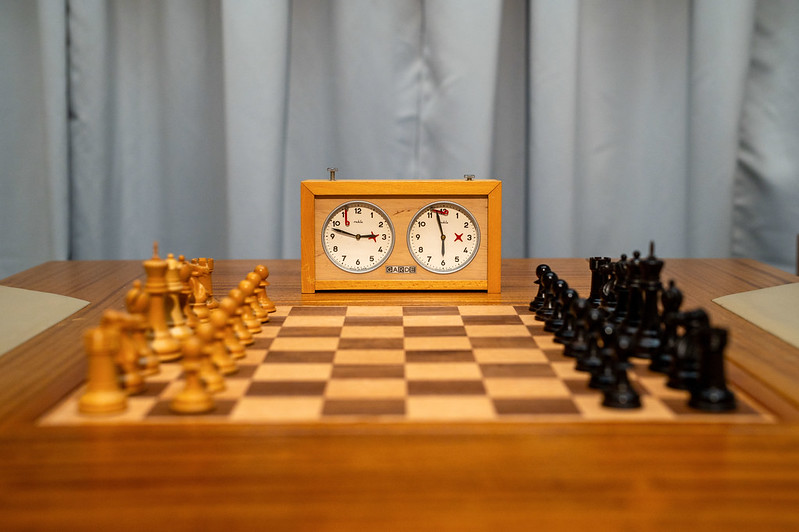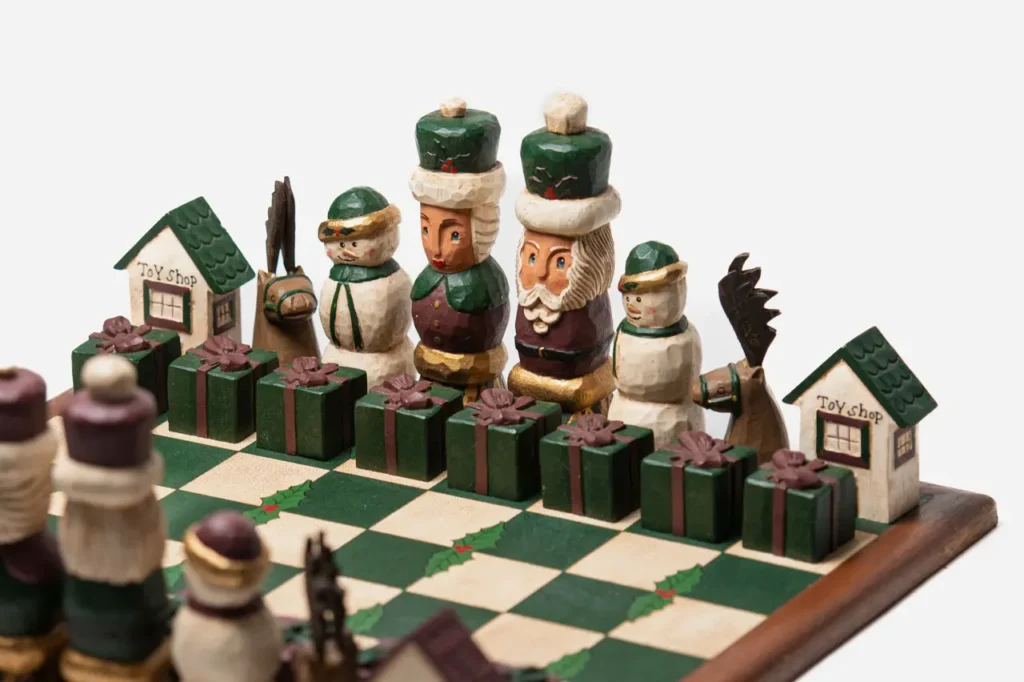March 23, 2017 - September 24, 2017
The Imagery of Chess: Saint Louis Artists
The groundbreaking 1944 exhibition The Imagery of Chess sought to challenge the general conventions of the ancient game.
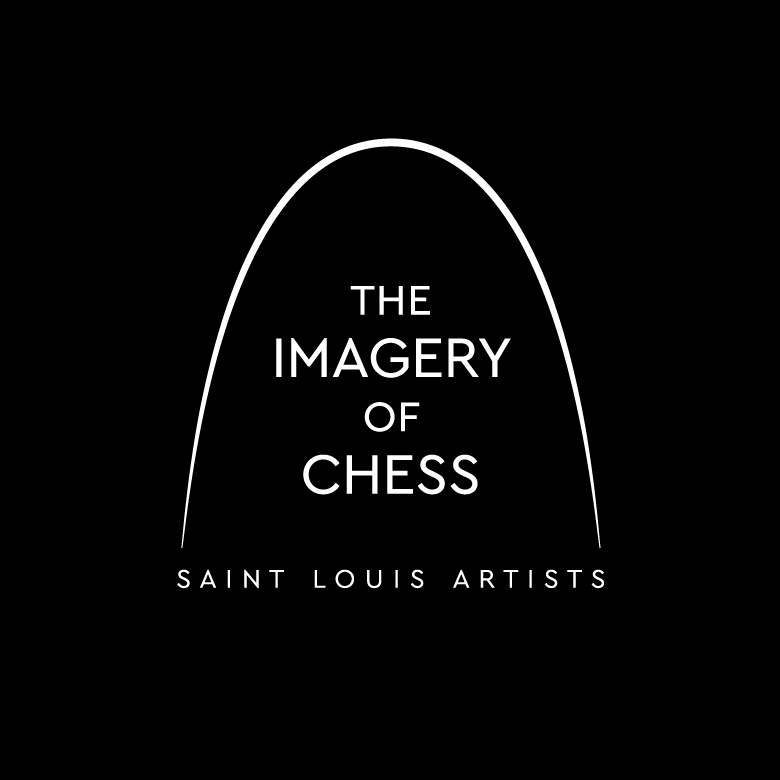
Organized by Marcel Duchamp, Julien Levy, and Max Ernst, the show included the work of over 30 painters, photographers, sculptors, critics, and composers, among others. Each created artwork or performances inspired by and challenging preconceived notions of chess. Though a few of the participating artists—Alexander Calder, Man Ray, André Breton, and the organizers—were well known at the time, others such as Matta, Arshile Gorky, Robert Motherwell, and John Cage would emerge as significant figures in the second half of the 20th century. The highly publicized exhibition was well received by the chess, art, and general communities, and the project went on to inspire artists over the last 70+ years to reinterpret the game in an artistic way.
With a mission to interpret the game of chess and its cultural and artistic significance, the World Chess Hall of Fame was honored to celebrate the history of the 1944 show in Fall 2016/Winter 2017 in Designing Chessmen: A Taste of The Imagery of Chess, by showcasing some of the original artwork and reproductions of pieces from the original exhibition. We are now proud to present The Imagery of Chess: Saint Louis Artists, featuring 20 leading local artists, writers, designers, musicians, and composers and their newly commissioned artwork and performances inspired by the game of chess.

Eugenia Alexander is a multimedia artist from Edwardsville, Illinois. She studied fine art and art history at Columbia College Chicago, but is largely self-taught, and currently lives and works in Saint Louis, Missouri. Alexander has painted for over ten years and is studying under her grandmother, master artist quilter Edna Patterson Petty. Subconsciously refining her visual works, Alexander has created her own genre and her own signature style, which viewers can easily recognize through the alluring repetitive line patterns that adorn her work. Her inspirations include traditional African symbolism and textile design as well as Afrofuturism, a genre of literature, art, music, and many other forms that features futuristic or science fiction themes incorporating black history and culture.
Alexander’s work has been featured in several group and solo exhibitions and events, including: Evolving Archetypes, SOHA Studio & Gallery, Saint Louis (2016); Powerful Black Women Artists, Vaughn Cultural Center, Saint Louis (2016); and Blended Spirits: Where Two Artful Souls Collide, Old North St. Louis Restoration Group (2015). Additionally, she has participated in Artscope’s Wall Ball Auction (2016). Media outlets including All the Art: The Visual Art Quarterly of St. Louis, Santa Clara University’s Explore Journal, and NPR Saint Louis Public Radio, among many others have profiled Alexander.

out of time, out of mind, 2017
Acrylic paint and fabric on canvas
50 x 55 x 3 in.
Collection of the World Chess Hall of Fame
In out of time, out of mind, artist Eugenia Alexander portrays a fictitious goddess of time and manipulation seeking to trick a player and negatively influence his or her game. Named Kaala, after the Sanskrit word Kaala (time), the goddess makes the player use up his or her time prematurely, see things that are not there, and second guess his or her moves. Her gold language moves the viewer through the painting, encouraging the player to forget that a chess game is in progress. Pictured at the center of the work, Kaala’s right eye controls time, and her left eye is “the manipulator,” which makes following the game more complex.
Alexander represents the moves of the game in the straight line work, which follows the movement of chess pieces in the game between Viktor Kupreichik and Jaime Sunye Neto at the 1989 GMA Beleares Open. She chose the game at random for its complexity. Other line work represents Kaala’s manipulations. Alexander, who has been studying under a master quilter, has incorporated African textiles into the representation of Kaala’s face. She often works with Nigerian and Ghanaian textiles and has designed textiles herself.

Brandon Anschultz received his MFA with a concentration in printmaking and drawing from Washington University in St. Louis in 2002 and his BA in painting and drawing from Louisiana Tech University in 1997. He creates paintings, sculptures, and installations that mainly investigate the space between painting and sculpture. Anschultz focuses on the materiality of painting and often employs loose narratives to guide his work.
His past solo exhibitions include Below Horizon, Regards, Chicago (2015); Suddenly Last Summer, Contemporary Art Museum St. Louis (2014); Pacer, Contemporary Art Museum St. Louis (2012); Press Pause, Philip Slein Gallery, Saint Louis (2012); Stick Around for Joy, Laumeier Sculpture Park, Saint Louis, and Longue Vue House and Gardens, New Orleans (2010); and Brandon Anschultz: Round, White Flag Projects, Saint Louis (2007). Additional group exhibitions include: Fact or Fiction, Truman State University, Kirksville, Missouri (2016); Bad Habits (Remember Me), fort gondo compound for the arts, Saint Louis (2016); You Are Looking Good, A Real Good Looker, Chicago Arts Coalition, Chicago (2016); The Tyranny of Good Taste, La Esquina, Kansas City, Missouri, and Columbia College Chicago (2013-2014); All That Heaven Allows, fort gondo compound for the arts, Saint Louis (2013); All Good Things Become Wild and Free, Carthage College, Kenosha, Wisconsin (2012); Die Erklärte Ausstellung, Künstlerhaus Klagenfurt, Klagenfurt, Austria (2012); Violence, Exhibition Agency, Chicago (2010); Due Diligence Done, Tiger Strikes Asteroid, Philadelphia (2010); Jasmine Plus B, Front Desk Apparatus, New York City (2009); and Amass, Monte Vista Projects, Los Angeles, and Boots Contemporary Art Space, Saint Louis (2009). Anschultz’s past residencies include ACRE in Steuben, Wisconsin, and La Cité internationale des Arts in Paris, France.
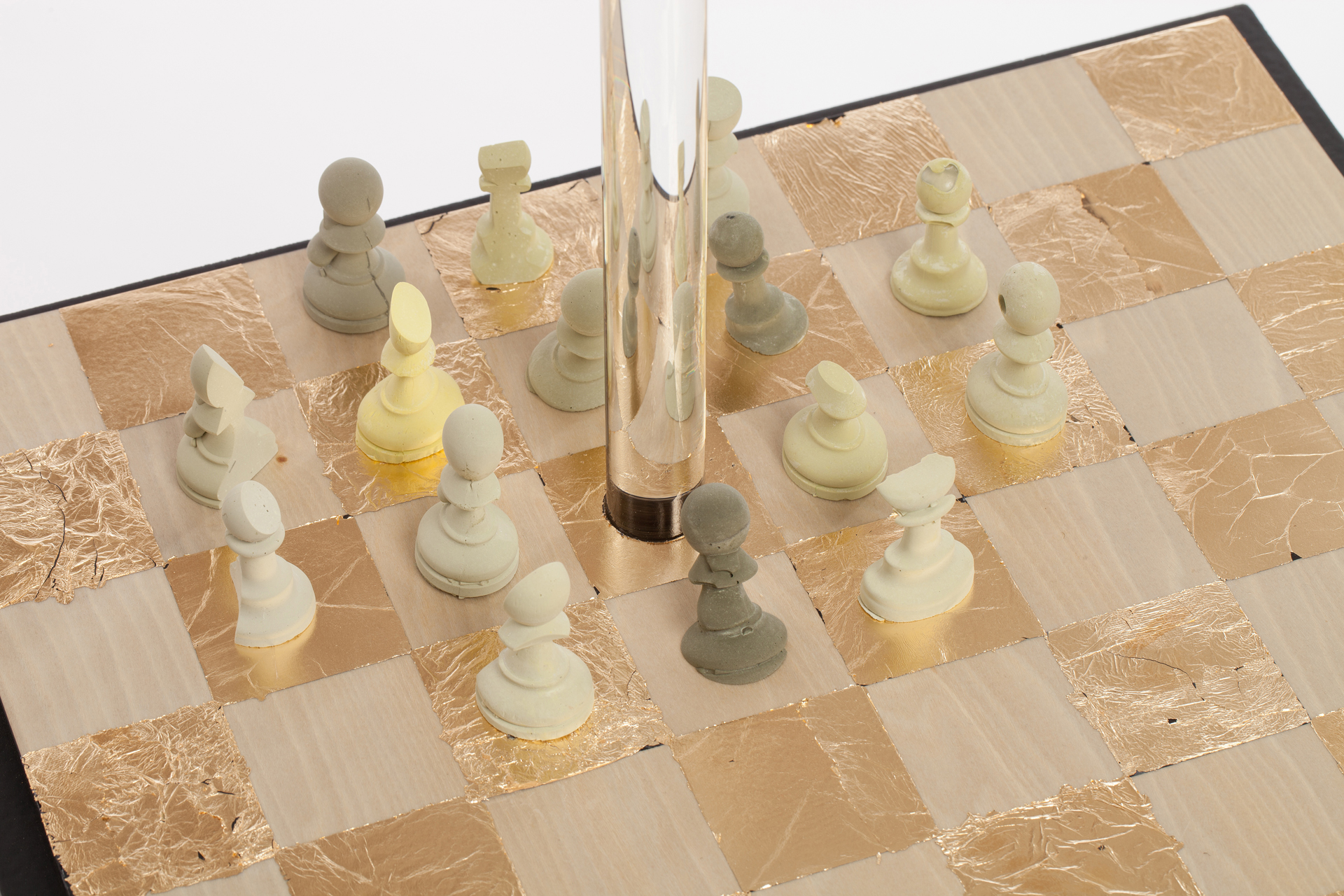
The King Elevated Above His Pawns, 2017
Cast plaster, glass, wool, gold leaf, latex and acrylic paint, and wood
64 ¼ x 16 ¾ x 16 ¾ in.
Collection of the World Chess Hall of Fame
Inspired by the diverse artistic approaches used by participants in the original The Imagery of Chess exhibition, Brandon Anschultz abandoned the concept of creating a functional chess set. Instead, in The King Elevated Above His Pawns, he uses a chess set as a metaphor for an autocratic ruler. The king is elevated above and protected by his cohort of rank and file pawns, which are hybridized and distorted versions of standard chess pieces. Rather than representing the standard light and dark teams, the pieces are a mixture of colors, all with a shade of tarnished gold. Anschultz states, “I created the piece by altering and copying existing chess pieces. I made many molds of pawns and cast them with tinted plaster, while both manipulating the molds and modifying the resulting casts. The king was created by repeatedly dipping a piece in paint and styling his crown of hair.”
The usage of chess (both as imagery and as metaphor) has a rich history both in art and in daily conversation, and even for those who are not steeped in the game, its general principals have an unavoidable presence in our culture. In his artistic practice, Anschultz generally focuses on material improvisation through abstract forms. At times, he uses a specific idea or theme as a starting point for his work. This exploration usually exists at an uncertain intersection of painting, sculpture, installation, and design. Here Anschultz uses the game of chess to explore concepts of authority and power
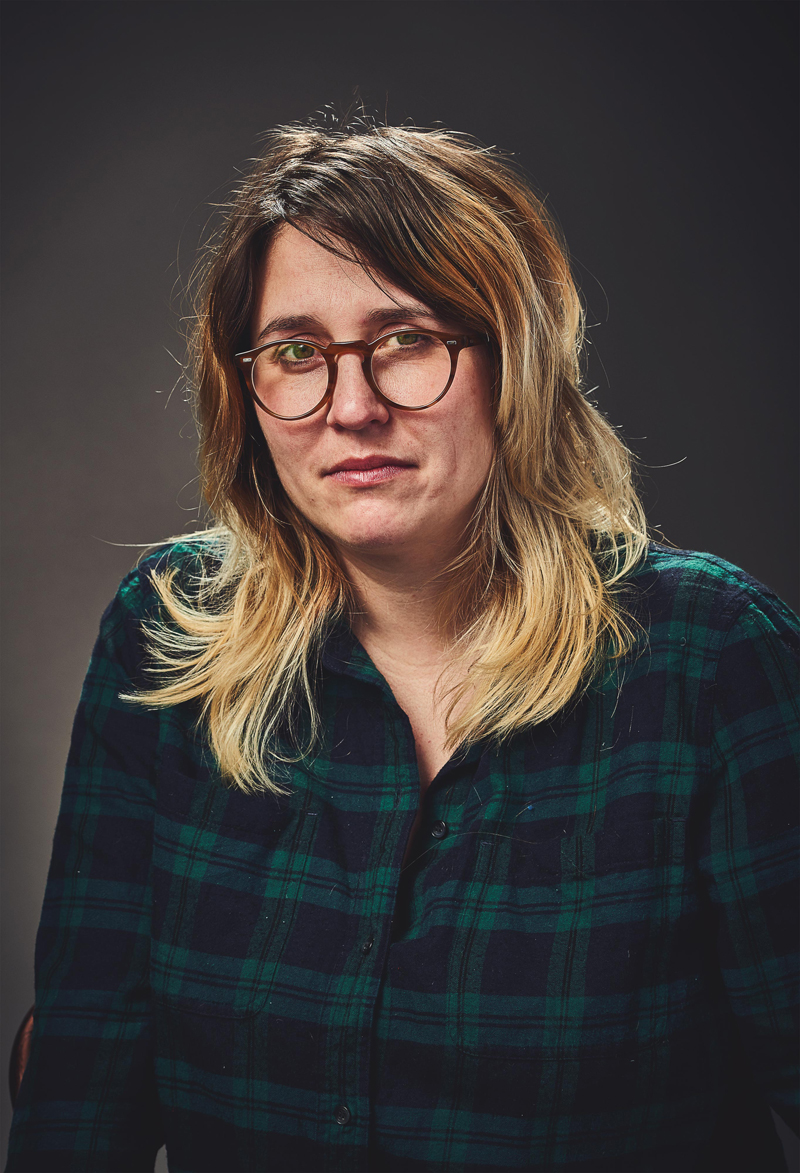
Jessica Baran is a poet, curator, art writer, and a lecturer at the Sam Fox School of Design & Visual Art. She also teaches in Saint Louis University’s Prison Arts & Education Program. Baran holds a BA in Visual Art from Columbia University, New York, and an MFA in Poetry Writing from Washington University in St. Louis. Across disciplines, her work constantly investigates the relationship between visual art and language. Baran has explored this topic in-depth through three poetry collections, including Common Sense (Lost Roads), which was released in fall of 2016.
Baran has curated exhibitions at the Contemporary Art Museum St. Louis; the Center for Creative Arts, Saint Louis; the Charlotte Street Foundation, Kansas City; and White Flag Projects, Saint Louis, among other venues. For four years she directed fort gondo compound for the arts (Saint Louis), a nonprofit community art space, where she oversaw an expansive program that included exhibitions, publications, and a poetry series. Baran is a recipient of numerous awards and fellowships, which include the Regional Arts Commission Artist Fellowship, Critical Mass Creative Stimulus Award, a PXSTL Project Grant, and a Marfa Dialogues Project Grant. Her second poetry collection Equivalents (Lost Roads, 2013) earned her the Besmilr Brigham Women Writer’s Prize, and her poetry has been nominated for The Pushcart Prize twice. Baran’s poetry and art criticism has appeared in Art in America, Artforum.com, Art Papers, A Public Space, BOMB, the Boston Review, the Denver Quarterly, Flash Art, Hyperallergic, the Riverfront Times, and the Village Voice, among many other publications.
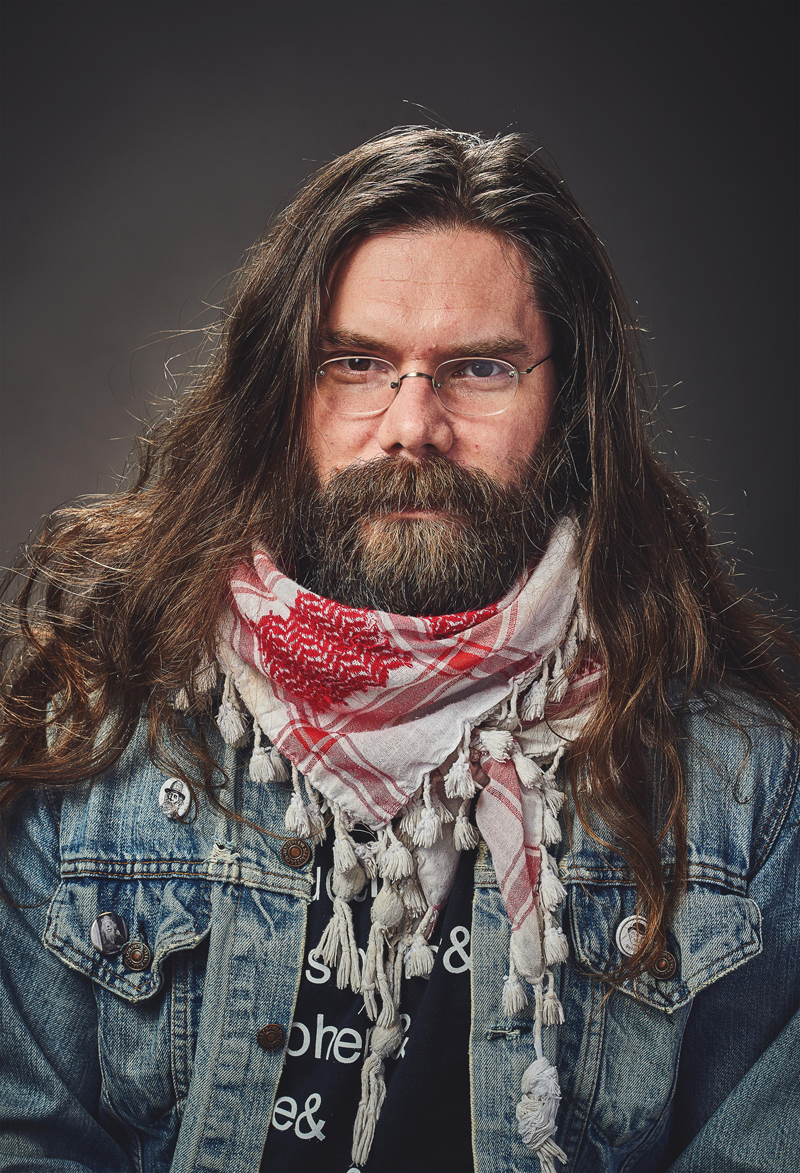
Nathaniel Farrell is a poet, collage artist, educator, and radio host. He spent his formative years growing up on a small farm in Western Pennsylvania where his father, Richard, a union plumber and steamfitter, and his mother, Maria, a public elementary-school teacher, raised him. Farrell holds a doctorate in English Literature from Columbia University and is the author of The Race Poems (Ugly Duckling Presse, 2005), which includes collages by Steve Dalachinsky, and Newcomer (Ugly Duckling Presse, 2014), a long poem narrated by an anonymous soldier and set in an undefined American-soil campaign.
Farrell’s work is consistently informed by a commitment to daily observation, environmental ethics, and the critique of nationalism. After living in New York City for fifteen years, in 2011 he moved to Saint Louis, where he now teaches college composition at Washington University in St. Louis and works for KDHX Community Media coordinating volunteer writers and photographers. Farrell has recently begun serving on the New Music Circle board of directors, and since 2015 he has hosted the experimental music program Cure for Pain, which airs Tuesdays from 11 am-1 pm on 88.1 KDHX. He lives in the Tower Grove South neighborhood with his partner and poetic collaborator, Jessica Baran.
Over the years, Farrell’s poetry has been published in 6×6, New York Nights, Greetings Magazine, VLAK, The Brooklyn Rail, and The Recluse. His current manuscript, Other Places, brings together three long poems devoted to real and imagined landscapes: from Forest Park and Lindell Boulevard, specifically the so-called Catlin Tract; to interstate scenery and suburban mall-scapes; to John Milton’s hell reworked in the vocabulary of evolutionary science, occult anthropology, and colonial exploration.
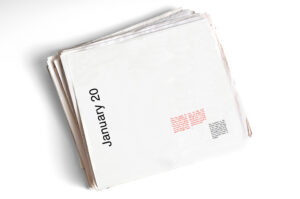
Jessica Baran and Nathaniel Farrell
Some Other Ways, 2017
Newsprint
10 x 15 in.
Collection of the World Chess Hall of Fame
Newsprint image courtesy of the artists
Some Other Ways is a prose-poetic serial comprised of daily entries written by Jessica Baran and Nathaniel Farrell during the first month of the 45th president’s term of office, from Inauguration Day to President’s Day (January 20-February 20, 2017). The resulting 64 poems chart the domestic life of the two poets—a couple—focusing on how their material stuff moves around them like chess pieces, representing tasks done or undone. While quotidian routines—taking out the trash, watering plants, and doing dishes—might be thought of as pawns, more deep obligations manifest as rooks or knights, such as caring for the dog or navigating travel. Figuratively, each poem documents the poets’ personal and socio-political maneuvers, be they in respect to their relationship, their professional lives, or, in a larger context, their roles as citizens in a volatile political landscape.
If the intersection of personal and political spaces serves as the sounding board for poetic content, the temporal structure of the calendar month serves as the project’s layout inspiration—each calendar page is a square where moves are made as the composition’s strategy unfolds. The poems themselves, then, while not written as explicit responses, use real time-and-space interactions to represent moves and counter-moves toward an endgame of romantic longevity, not conquest. In this respect, the sequence is a critical response to the “Game of Chess” section of The Waste Land (1922), in which Saint Louis-born poet T.S. Eliot used chess as a metaphor for the dissolution and debasement of romantic life among the seductions of the modern world. If Eliot’s metaphor represented the failure of culture as a failure of romance, Some Other Ways sets the stability of a household up as a bulwark against an unstable time. To embody the intersection of personal and political, the sequence has been printed in the form of a newsprint broadside—resembling a newspaper—in which each poem appears in the shape of a noted endgame strategy.
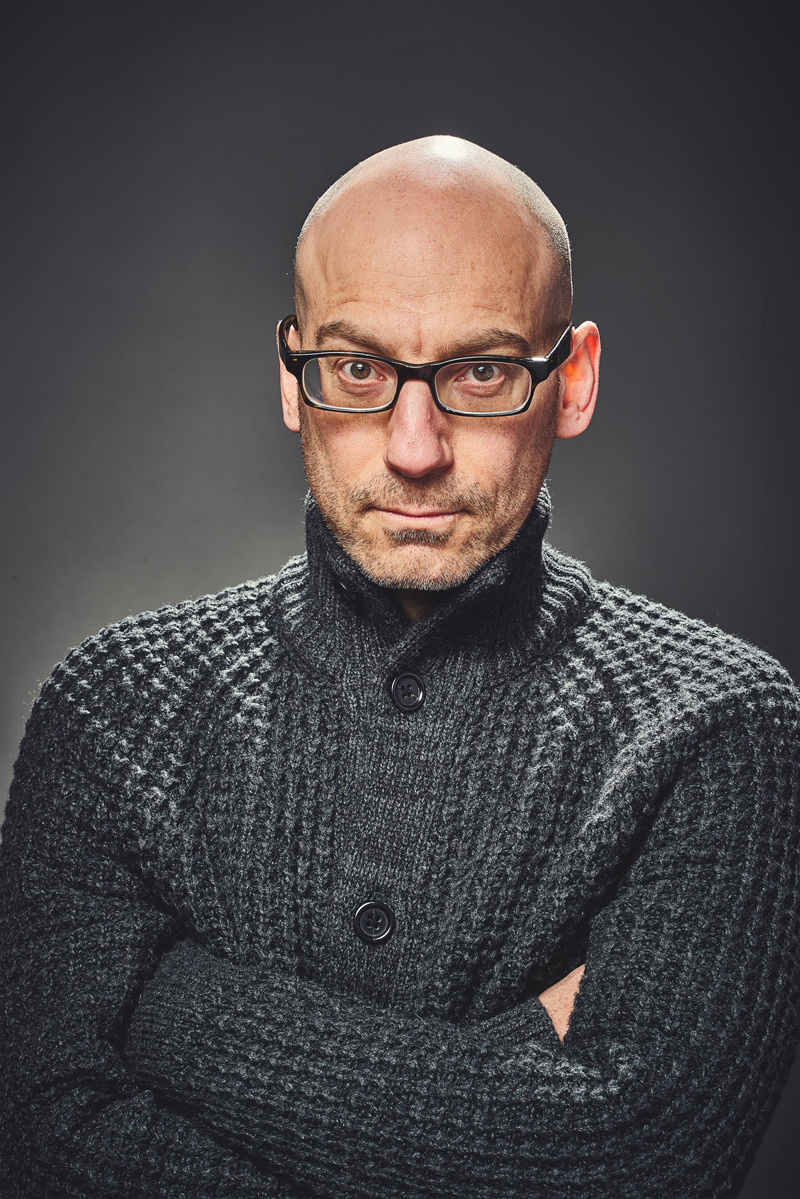
Martin Brief was born and raised in Chicago, Illinois, and earned his MFA from Southern Illinois University at Carbondale. His recent work—long-term, absurd, drawing-based tasks—interrogates aspects of our complex social and political fabric. Brief currently lives and works in Saint Louis, where he is an Associate Professor of Studio Art at Saint Louis University.
Brief’s work has been exhibited in solo and group exhibitions nationally and internationally in New York; Paris; Zurich; Washington, D.C.; Philadelphia; Chicago; and Saint Louis. Selected exhibitions include: A Brief History of Time, Danese/Corey, New York (2016); Amazon God, Contemporary Art Museum, St. Louis (2010); New Talent 2010, Gallery Joe, Philadelphia (2010); and A–acneform (The Dictionary Series), La Cité internationale des Arts, Paris (2006). Additionally, his work is in several public collections, including the Joan Flasch Artists’ Book Collection at the Art Institute of Chicago; Center for Creative Photography, Tucson, Arizona; and the Hawai’i State Foundation on Culture and the Arts, Honolulu. Brief participated in the Great Rivers Biennial and recently received fellowships from the Howard Foundation and the MacDowell Colony. His work is represented by Danese/Corey, New York.
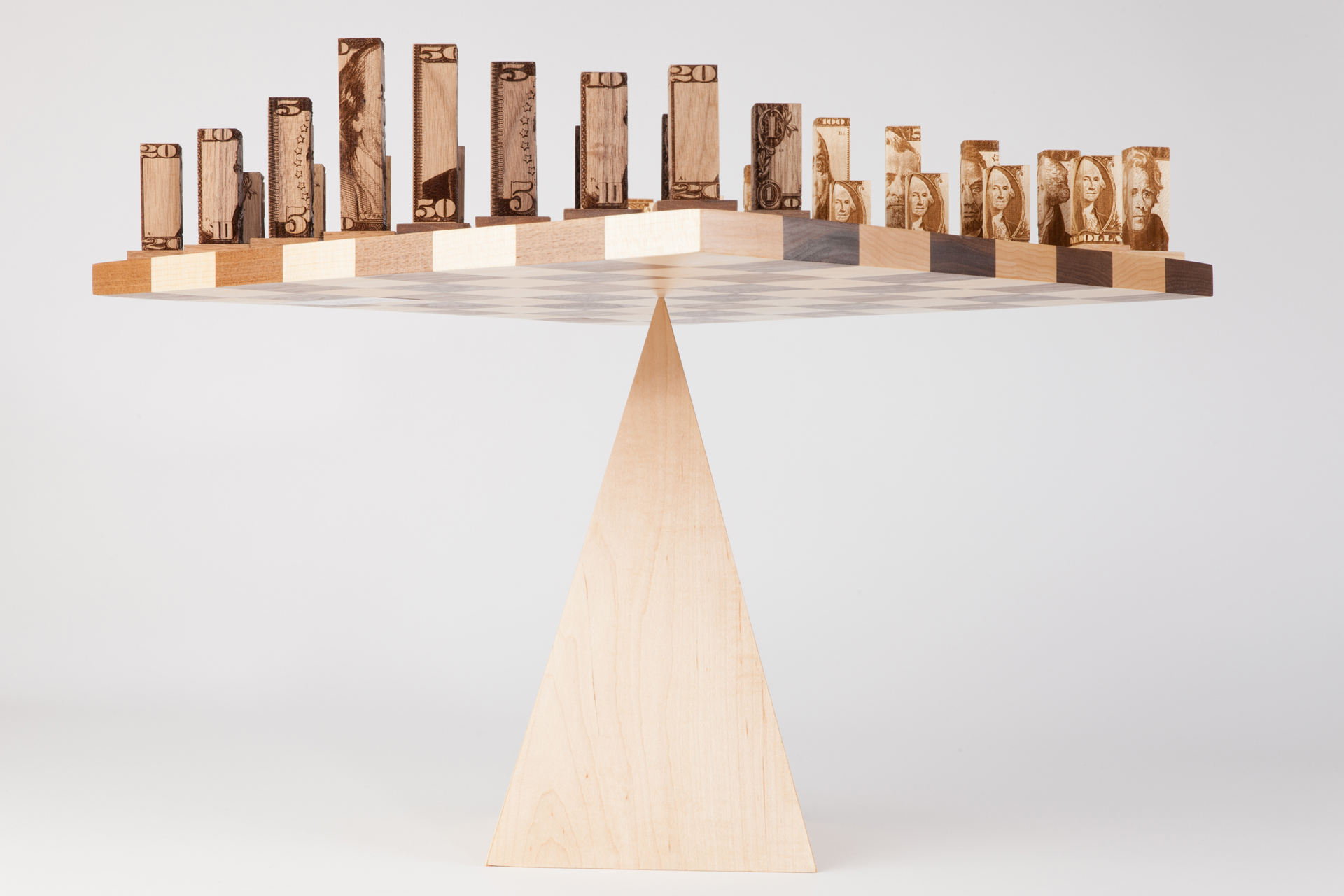
Martin Brief
The Game, 2017
Walnut and maple
King Size: 3 ½ in.
Board: 12 x 16 x 16 in.
Collection of the World Chess Hall of Fame
Featuring a chessboard balanced precariously atop a pyramid, The Game is inspired by what Martin Brief describes as “this dark historical moment and the bleak, uncertain future.” Yoko Ono’s famous anti-war chess artwork, White Chess Set (first produced in 1966, with later versions titled Play It by Trust), which features a white chess table and pieces, influenced the development of this work. In both pieces, players are challenged to work together. However, in Brief’s piece, if they fail to cooperate, he states that “the result is catastrophe rather than confusion, as in Ono’s game.” He continues, “The physical structure of this set is designed to create tension before the game begins. There is no progression into danger; it begins in a state of precarious equilibrium in which the first move could be the last.”
The Game reimagines the chess set, much like many of the works in the original The Imagery of Chess exhibition. The pieces, etched using a laser cutter, are emblazoned with images from American currency. Though this differs from his recent work of text-based drawings, it relates to the artist’s interest in interrogating aspects of our complex social fabric. Additionally, this piece, like some of his other work, creates a somewhat absurd, impossible situation for the viewer. A viewer can interact with his drawings by getting up close and reading the text or by standing back and let the text transform into pure form. Neither reading alone is complete. This piece functions similarly in that it is simultaneously beautifully balanced and full of imminent catastrophe, though never quite settling into either.

Bruce Burton received his BA from Southern Illinois University in Edwardsville and lives and works in Belleville, Illinois. His work explores the artmaking process; gathering, sorting, collating, associating, and staging/displaying. Burton’s art is rooted in opposing principles, such as thinking and making, mind and body, rational and organic, structure and experimentation, and mechanical and handmade. He investigates the relationships among the object (found or created), the environment, and the viewer.
Burton’s process of curating and presenting objects within a defined space is intuitive and happens as a reaction to the space itself. He remakes the space with an eye that is as equally attuned to contemporary materials and design as to natural oddities. Using a collection of objects and materials, Burton attempts to strike a balance between the past and present as well as the personal and the historical, while arranging new constellations which react pointedly to the spatial situation of the exhibition space.
His work has been featured in solo exhibitions including: Staging the Remains, fort gondo compound for the arts, Saint Louis (2015); Observation and Formulation, PSTL Gallery, Saint Louis (2009); Sullivan’s Systems, The Sheldon Art Galleries, Saint Louis, (2008); and all & one, Maps Contemporary Art Projects, Belleville, Illinois (2007). Group exhibitions include: Off Modern: In What Time Do We Live?, The Luminary, Saint Louis (2017); Perspectives, Memphis Brooks Museum of Art, Memphis (2007); and Live Action: An Exhibition of Interactive and Performance Art, White Flag Projects, Saint Louis (2006); among others.
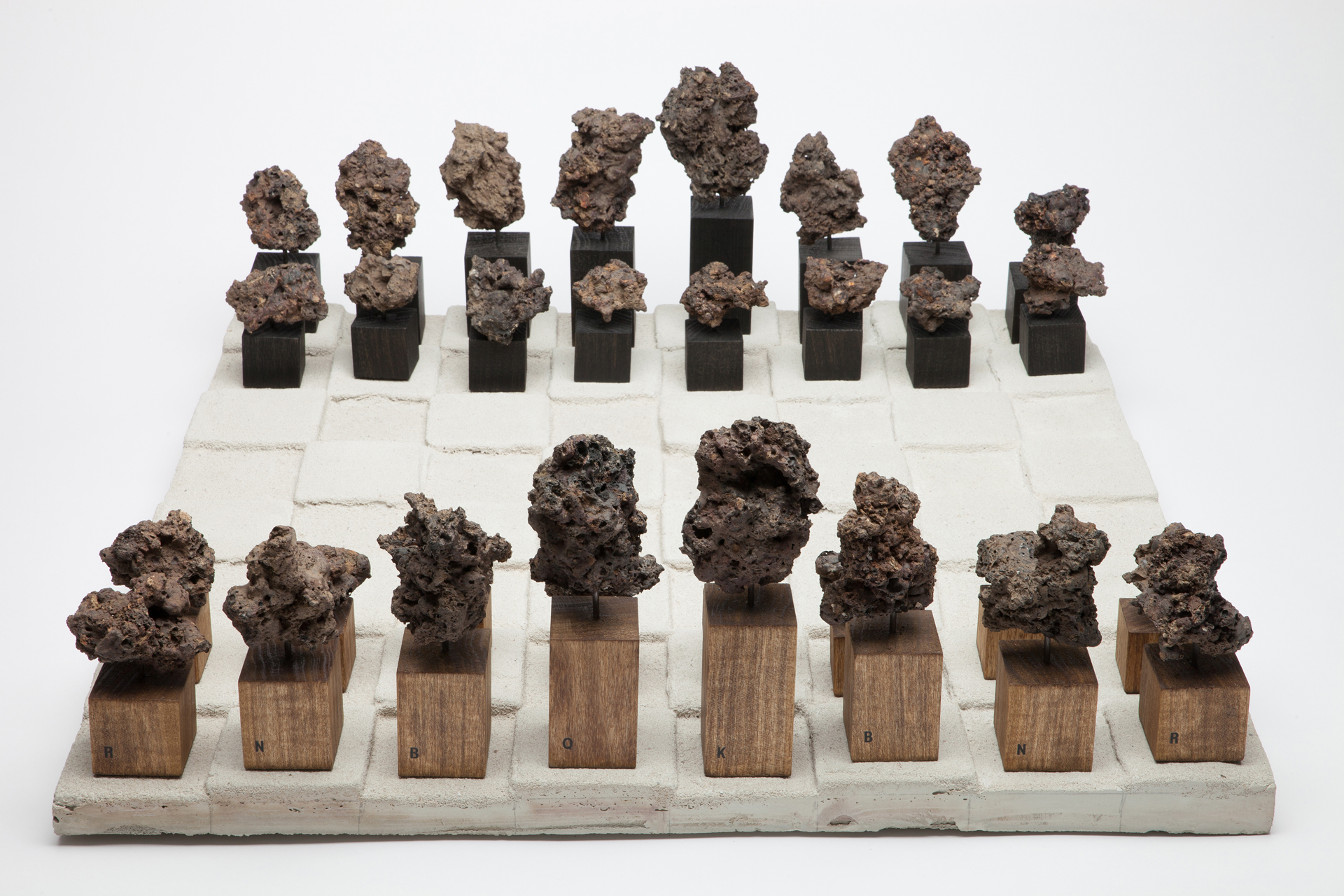
Bruce Burton
Capturing Fragile Instants, 2017
Concrete, slag, steel, and poplar wood
King Size: 7 ½
Board: 24 x 24 in.
Collection of the World Chess Hall of Fame
Capturing Fragile Instants is inspired by Bruce Burton’s current body of work, which investigates ideas of modernism, figurative abstraction processes, Asian garden design, and specifically in this case, Chinese scholar stones or Japanese suiseki (beautiful stones that inspired artists and writers). Rather than using stones, Burton instead utilizes the castoffs of burned trash, commonly called slag, dating from the first part of the 20th century and excavated from his backyard. The use of mundane materials, often found, are key to his work. While not formed by nature, slag is naturally formed during the burning process, and each piece is unique. The slag used in this chess set contains all the aesthetic values cherished in scholar stones: color, shape, markings, and surface. Burton states that, “By re-contextualizing the slag I aim to embed new histories into the material.”
Burton was also interested in the chess pieces all having individual personalities and breaking down the traditional hierarchy of a chess set. He sought to create a degree of confusion during play as the pieces become difficult to discern from one another. This elevates the theatricality of play and allows each piece to gain significance based on its proximity to other pieces. Over the course of the exhibition, the artist will move the pieces in the progress of a chess game.

Juan William Chávez is an artist and cultural activist who was born in Lima, Peru, and was raised in Saint Louis, Missouri, where he works and lives. Chávez earned his BFA from the Kansas City Art Institute and his MFA from the School of the Art Institute of Chicago. In his work, he creates and shares space in the built and natural environments to address community identified issues. Chávez’s studio research incorporates drawings, films, photographs, architectural interventions, and unconventional forms of beekeeping and agriculture that utilize art as a way of researching, developing, and implementing creative placemaking and socially-engaged projects. His studio research is often presented as multimedia installations, with exhibitions focusing on themes of the urban environment, ecology, sustainability, craft/labor, activism, identity, and archaeology of place.
Chávez’s work has been highlighted in solo exhibitions including: Artist-In-Residence Exhibition, ArtPace, San Antonio (2016); Living Proposal: Pruitt-Igoe Bee Sanctuary 2010-2012, Laumeier Sculpture Park, Saint Louis (2012); and Drawings from the Cave, Contemporary Art Museum St. Louis (2008). His work has also been featured in many group exhibitions, such as: The Highlights Presents a Video Screening, the Harris Lieberman Gallery, New York (2008); Heartland, Van Abbemuseum, Eindhoven, the Netherlands (2008); and Video 2005, Art in General, New York (2005).
Chávez founded Boots Contemporary Art Space (2006-2010), a non-profit organization that offered support to emerging artists and curators. In 2011, he established Northside Workshop, a nonprofit art space dedicated to addressing community identified issues in North Saint Louis. Chávez has received awards and grants from the John Simon Guggenheim Memorial Foundation, Creative Capital, the Graham Foundation for Advanced Studies in the Fine Arts, Kindle Project, Art Matters, the Gateway Foundation, and the Missouri Arts Council.
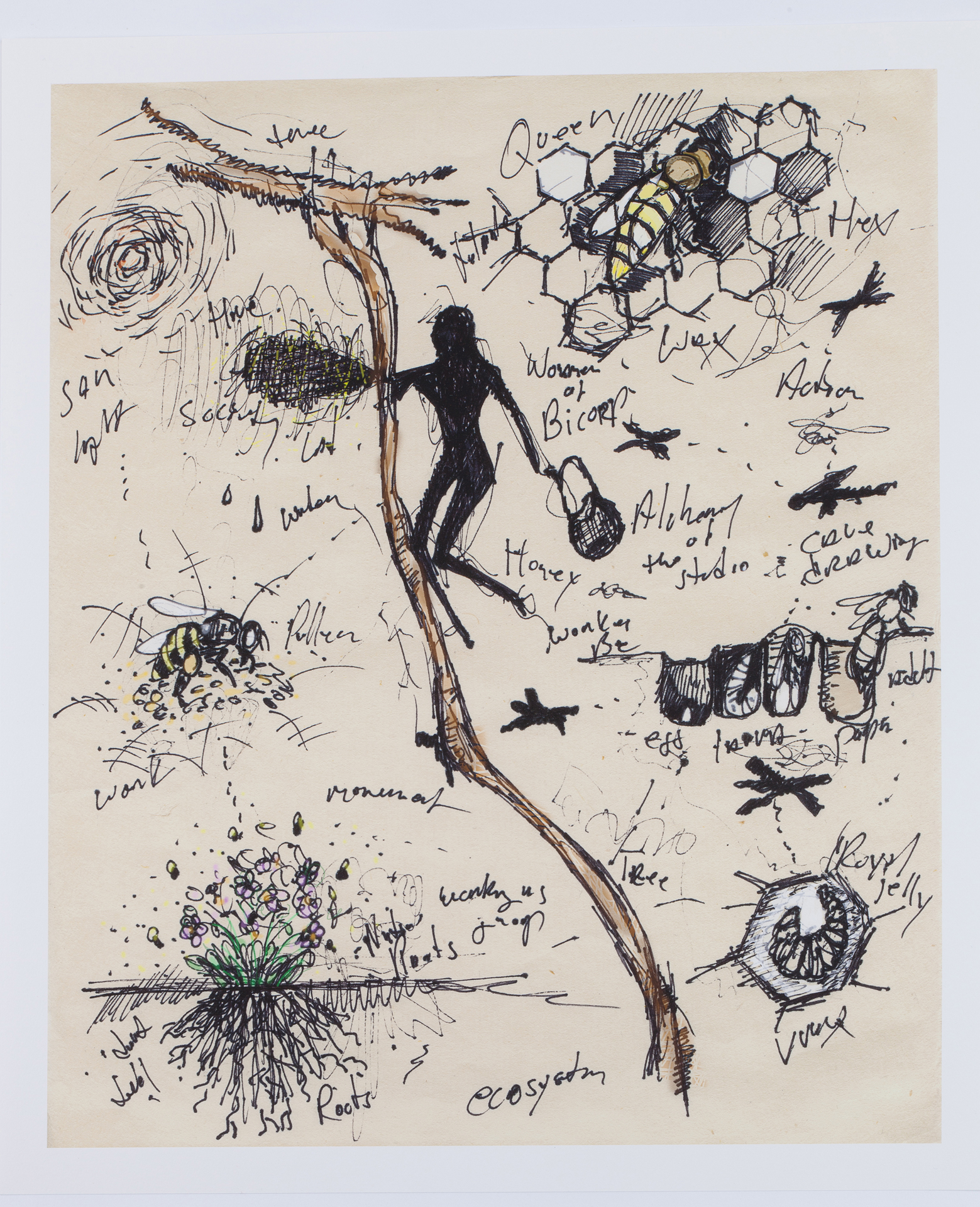
Juan William Chávez
Queen, 2017
Archival digital print
Print 5 of 5
20 x 24 in.
Collection of the World Chess Hall of Fame
With imagery related to the life cycles of bees and beekeeping, Queen celebrates feminine energy and power. The title alludes to both the queen as the most powerful chess piece and the queen bee, whose presence is central to a hive. Juan William Chávez has been a beekeeper for five years, and the images and text in this print represent his field notes, which are written and drawn from memory. As chess pieces are ascribed different roles and patterns of movement in the game, bees have roles in the hive, some changing over the course of their lives. Here, Chávez shows a queen surrounded by royal jelly as well as worker bees, which are also female, gathering pollen, cleaning the hive, and caring for young.
At the center of Queen is an image of the Man of Bicorp, an 8000-year-old-cave painting, which is the first representation of beekeeping. The figure climbs up a vine to collect honey. Though scholars believe the figure to be male, Chávez discovered that many of the villagers in the area where the cave is located believe it to be female. Paired with his observations of bee behavior, the artist presents a statement about the relationships among humans and bees, and how the two groups have depended on each other for survival for thousands of years. Inspired by drawings and prints in the 1944 The Imagery of Chess exhibition, Chávez first recorded his observations on a clipboard-sized piece of Japanese paper. He then worked with Hare & Hound Press to enlarge the work.

Deborah Douglas is a mixed media artist living in Saint Louis, Missouri. She received her BA from Truman State University in 1988 and her MFA in Painting and Printmaking from Southern Illinois University at Edwardsville in 1991. Since that time Douglas has taught both art history and studio art. She is currently an Associate Professor of Art and Art History at Saint Louis University, where she also serves as the director for the Art History program. Additionally, Douglas has served as a juror for numerous professional and student art exhibitions. Her artwork addresses issues of gender, feminism, and empowerment through personal and societal imagery.
Douglas has exhibited extensively both regionally and nationally. Her most recent solo exhibitions include: Lucky Fortune: Mixed Media Work by Deborah Douglas, Fontbonne University, Clayton, Missouri, (2016); Deborah Douglas-Pop Up Exhibit of Mixed Media Work, Saint Louis University, Madrid (2016); and Deborah Douglas: Hard, Cold Facts, Messing Gallery, Saint Louis (2015). Recent invitational exhibitions include: Exposure: 10th Anniversary Exhibition, 210 Gallery, University of Missouri St. Louis, (2016) and Snap to Grid, Los Angeles Center for Digital Art, (2015). Her upcoming solo exhibitions are Alternative Facts (1965-2017) at the Schmidt Art Center in Belleville, Illinois (May 2017) and Past, Present, Future Tense at The Sheldon Art Galleries, Saint Louis (March 2018). Douglas’s work has been reviewed in publications including the Kansas City Star, the St. Louis Post-Dispatch, Intermission Magazine, the Riverfront Times, The Beacon, and the Columbia Daily Tribune.
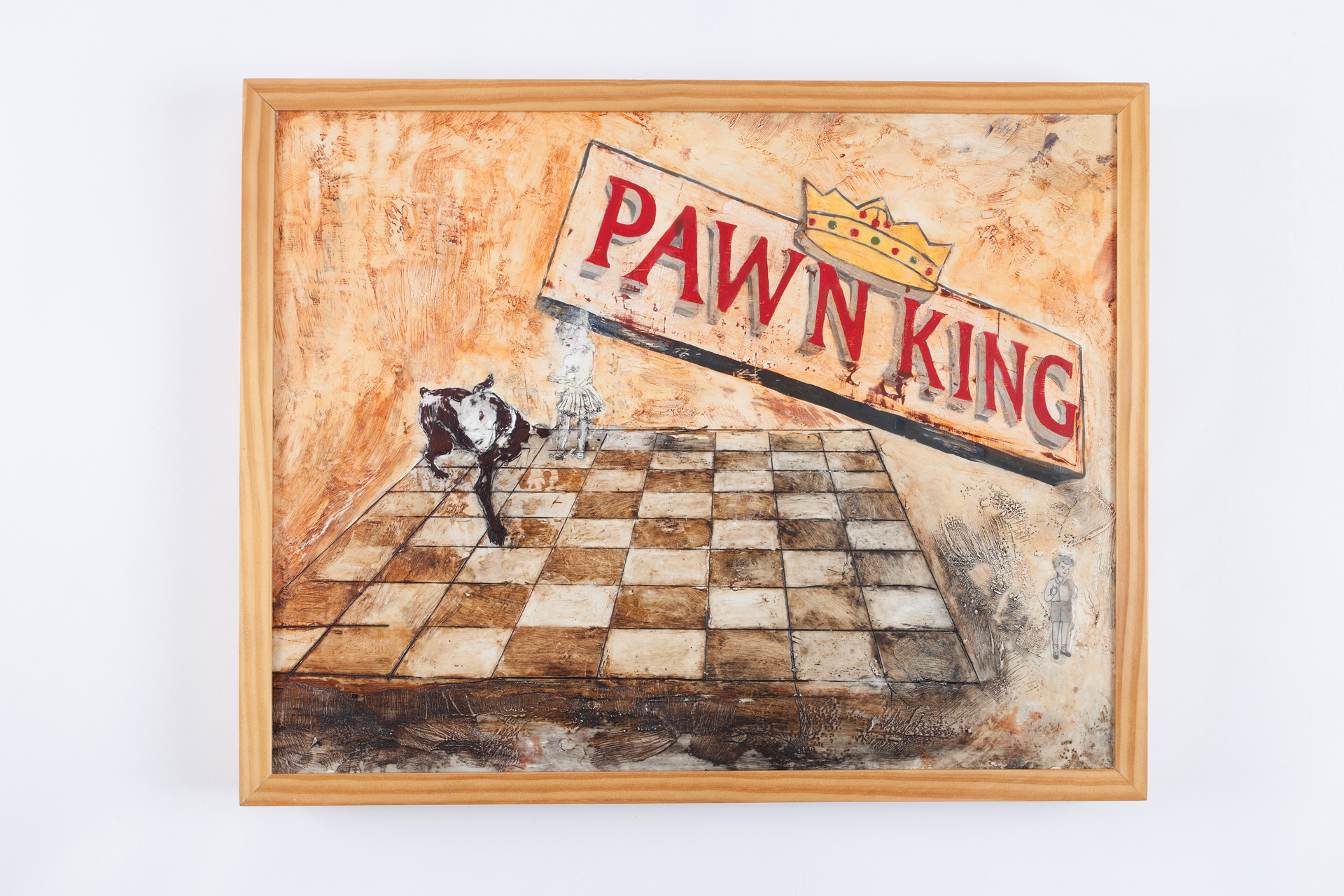
Deborah Douglas
Pawn King, 2017
Encaustic, collage, and oil on cradled panel
16 x 20 in. (17 x 21 in, with frame)
Collection of the World Chess Hall of Fame
Pawn King pictures a girl and a boy, two parts of Deborah Douglas’s visual vocabulary that can, though do not always, refer to the artist and her brother. Here, the boy, discarded and alone at the far right, represents the pawn, while the girl, who is writing the sign, personifies the king. The ghost dog acts as a bishop and is protecting the girl. The work’s title refers to a specific business in the Saint Louis area, chess pieces, and the idea that it is possible to become a pawn in society or in personal relationships.
Douglas states, “My art often involves double meanings of words and their assumed context. My interests are wrapped up in issues of domesticity: typically including references to cultural and societal issues of gender and sexual equality. The incorporation of decorative patterns and/or text can create another layer of form and meaning to personal or invented narratives. I do not play chess myself, but am interested in the pieces and the pattern of the board in the same way that I approach much of my imagery; by creating a narrative around it.” Pawn King is painted in encaustic (a method employing beeswax, damar resin, and pigment), as well as oil paint, and collaged vellum on a wooden panel. Douglas appreciates encaustic because it forces her to think in a reverse method while she works.
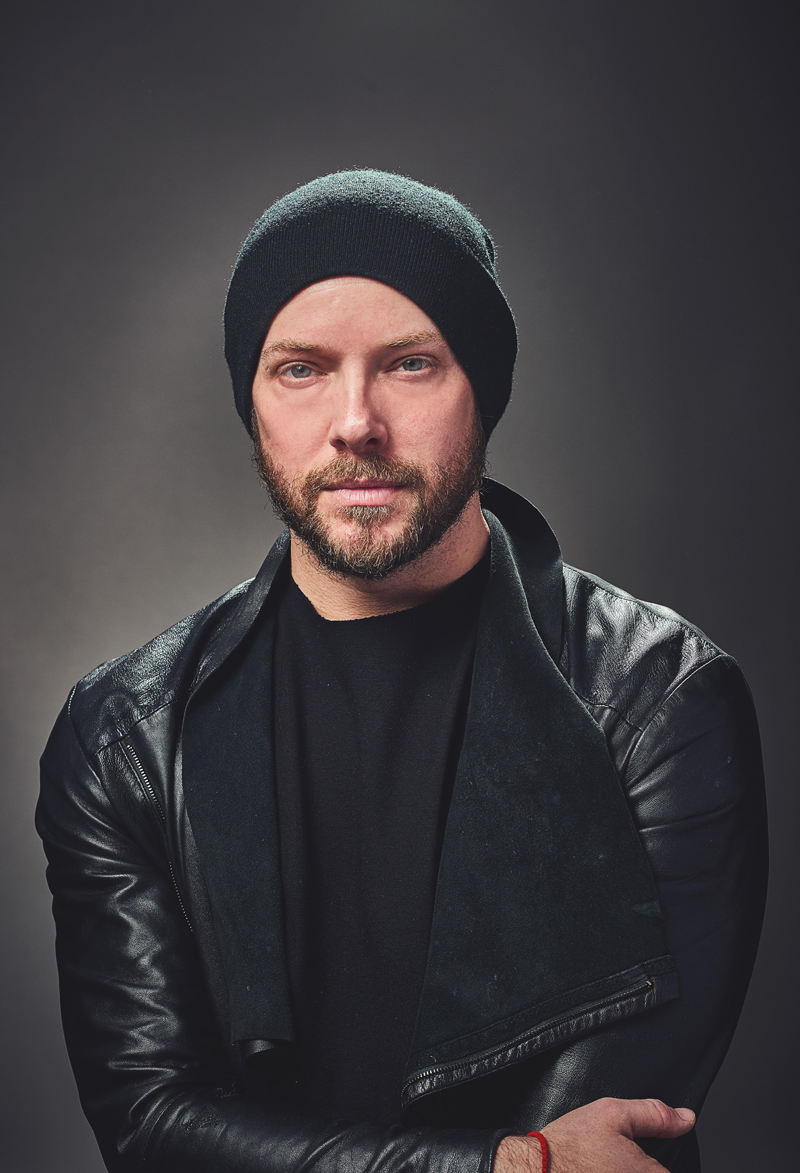
Michael Drummond is a veteran of Project Runway season eight whose client list includes actress Tika Sumpter, New York Fashion Week founder Fern Mallis, and supermodel and television host Heidi Klum. Largely self-taught, the multi talented artist works as a fashion design consultant and textile designer for SKIF International, produces his own line of clothing under his given name Michael Drummond, and is a commercial stylist for print and film. In his work, he seeks to marry practicality and dramatic design. Drummond loves large scale prints, delicate knits, simple comfortable shapes, deconstruction, and a dark palette. Rather than creating a new collection twice each year, he designs by building on a concept that could take three years to come to fruition. This is a process akin to creating a narrative and allows Drummond to choose a more thoughtful and ethical approach to clothing design with an end goal of creating interesting, timeless clothing that will work in his clients’ wardrobes for years to come.
Drummond’s work has been featured in several exhibitions, including: Little Black Dress: From Mourning to Night, Missouri History Museum, Saint Louis (2016); Spread, Reese Gallery, Saint Louis (2016); Pants!, Regional Arts Commission, Saint Louis (2016); A Queen Within: Adorned Archetypes, Fashion & Chess, World Chess Hall of Fame, Saint Louis (2013-14); Unraveled: Crossing the Line Between Fashion and Art, Sheldon Art Galleries, Saint Louis (2007); and Layered, Stitched, Assembled, Art St. Louis (2006). In 2013, he curated Dressed, an exhibition at the Regional Arts Commission, Saint Louis. Drummond has also worked as a costume designer for many operas, dances, and theatrical productions in the United States and Europe. The most recent include: Medea, The Junction, Dubai, United Arab Emirates (2017); Kinetic Field Work, Washington University Dance Theatre, Saint Louis (2011); and Three Penny Opera (co-designed with Bonnie Kruger), Washington University Dance Theatre, Saint Louis (2011). He has shown his work in countless fashion shows, including Mercedes Benz Fashion Week, New York (2010). In 2017 his work has been shown at Omaha Fashion Week; Kansas City Fashion Week, Kansas City, Missouri; Nashville Fashion Week; and The Factory Fashion Show, Saint Louis.
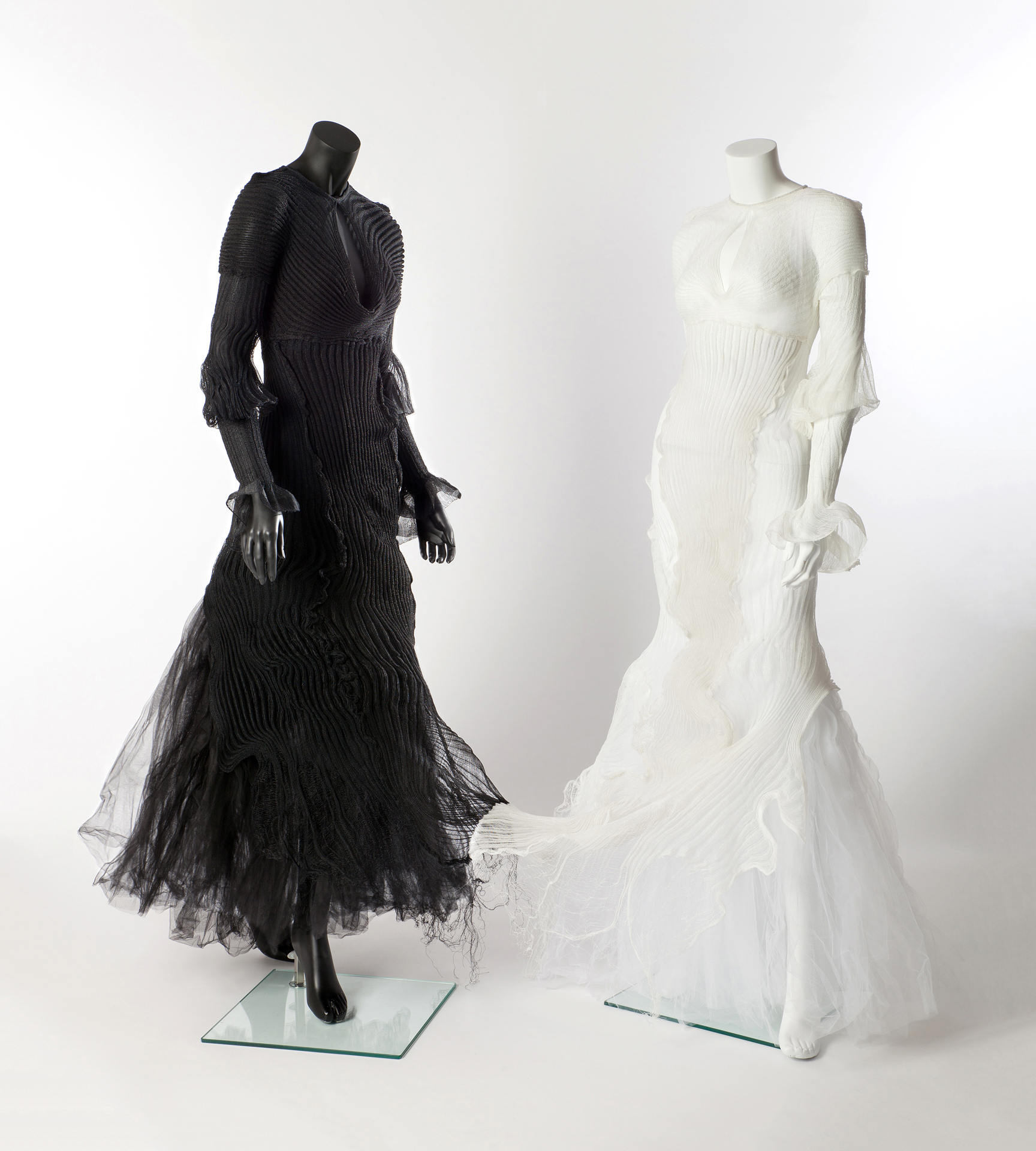
Michael Drummond
Queens, 2017
Polyester yarn and nylon microfilament
56 x 60 x 30 in.
Collection of the World Chess Hall of Fame
In Queens, Michael Drummond explores the current global political climate through the medium of fashion. Two dramatic dresses in black and white are attached at the hem—if the figures wearing the dresses were to pull away from each other the connection would be severed. Influenced by the work of Alexander McQueen, Comme des Garçons, and Maison Margiela, Drummond often uses deconstruction in his work, marrying art and fashion. Here he uses it to illustrate that when someone hurts others, they are also harming themselves. Drummond, who seeks to create narratives with his avant-garde designs, emphasizes our interconnectedness and the need to collaborate to confront serious challenges our society faces in Queens.
Both Yoko Ono’s anti-war White Chess Set (first produced in 1966, later versions titled Play It by Trust) and a quote from Robert F. Kennedy’s April 5, 1968, speech On the Mindless Menace of Violence influenced Drummond in the creation of this piece. In Ono’s set, all of the pieces and squares on the board are white, posing a challenge to players who seek to defeat each other and encouraging collaboration and creativity. In Kennedy’s speech, given before the Cleveland City Club the day after the assassination of Dr. Martin Luther King Jr., he lamented the effects of violence on American society, stating “…this much is clear, violence breeds violence.”
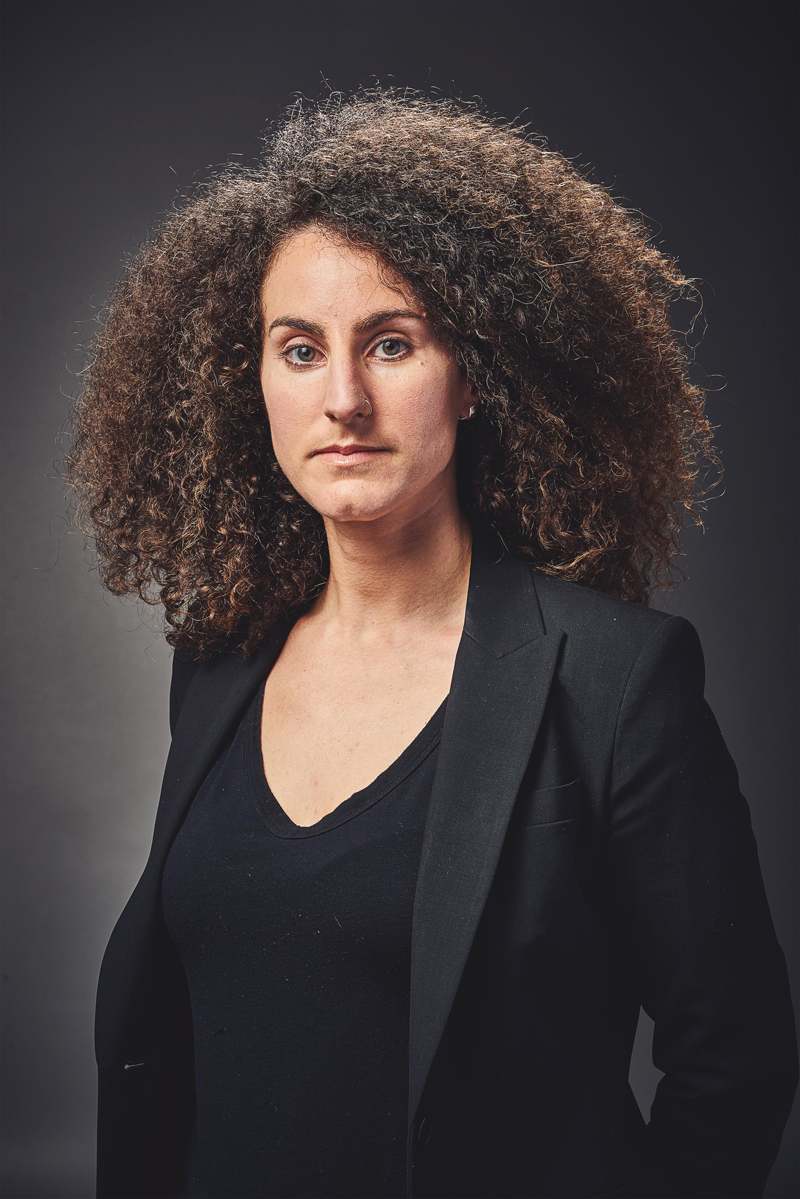
Kristin Fleischmann Brewer is a painter and sculptor working and living in Saint Louis, Missouri. In May 2011, Fleischmann earned her MFA from Washington University in St. Louis, where she was the recipient of the Mr. and Mrs. Spencer T. Olin Fellowship for Women. She earlier received her BFA in Painting from the University of Denver in 2007. Fleischmann expands her creative practice through curatorial projects, community organizing, and teaching. She currently works as the director of public projects and engagement at Pulitzer Foundation for the Arts, where she collaborates with local and national artists and thinkers to curate public programs and complete artist commissions. Fleischmann also co-founded and from 2012-2014 directed Enamel Art Space in Saint Louis, Missouri with artist Katie McCullough. The venue exhibited the work of local and national visual artists and poets. In 2015, Fleischmann co-founded Citizen Artist St. Louis, which she runs with local artists in order to organize artists around public policy and politics locally and nationally.
Fleischmann has exhibited in multiple venues in Denver, Saint Louis, New York, and Berlin. Selected exhibitions include: Some Things Precious, The Clothesline, Saint Louis (2016); Talk for an Hour, Des Lee Gallery, Saint Louis (2015); and Absences and Obsessions, Craft Alliance Center of Art + Design, Saint Louis (2011). She has been awarded artist residencies and fellowships including the Creative Community Fellowship with National Art Strategies (summer 2015), and two residencies with The Luminary: a studio residency (spring 2012) and the FLOAT Residency with Italian Collective Radical Intention in (summer 2014). She will be a resident artist at the La Cité internationale des Arts in Paris in summer 2017.
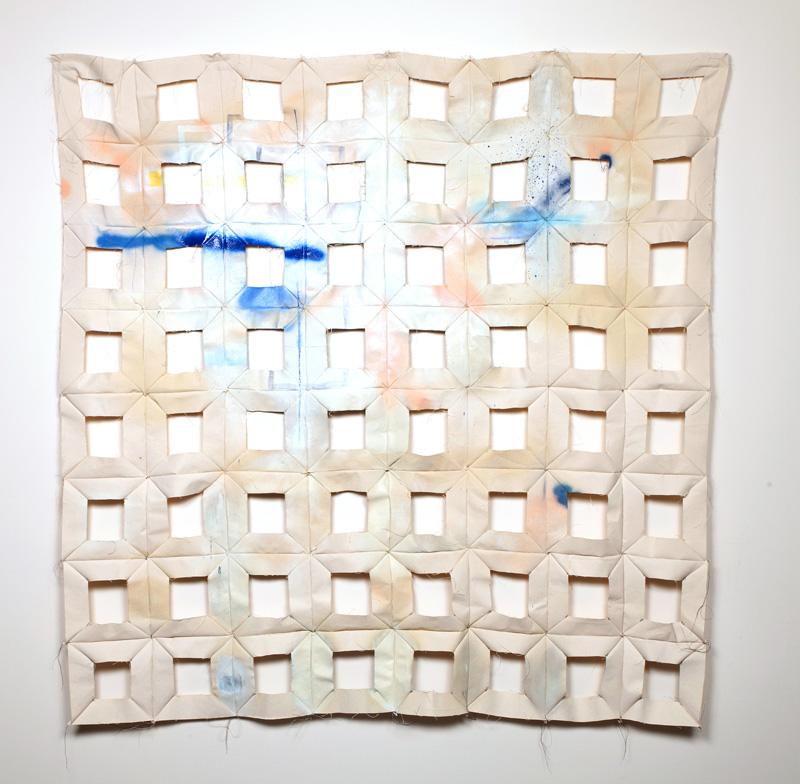
Kristin Fleischmann Brewer
64 Squares, 2017
Acrylic paint, canvas, and thread
64 x 64 in.
Collection of the World Chess Hall of Fame
64 Squares calls attention to the edges of the chessboard—the 8×8 grid, the 64 squares sitting in tension. The sewn seams of raw canvas create the boundary, referencing the strength and delicateness of the chessboard grid system. The skeletal, soft, naturally-toned object hangs like a tapestry and becomes the framework where a series of chess matches is documented. Fleischmann invited artists to play games of chess with her over the course of six weeks in January and February. She documented the games through a series of marks referencing their tone and tenor, which were translatedonto the canvas grid structure.
Prior to her participation in this exhibition, Fleischmann had always been intrigued by the game of chess, and through this commission learned about the game’s history, strategy, and methodology. As a painter, she was initially drawn to the aesthetics of chess—the grid of 64 squares, in particular, as it relates to the art historical grid of minimalist painting. After teaching herself how to play online and talking with friends, Fleischmann became most interested in the edges of the grid as lines of tension between players and pieces. How does the grid function to create tension? What happens when a player crosses the threshold of the grid, taking a risk to move a piece from here-to-there? What traces are created in the player’s consciousness? How might these manifest physically through the language of painting? The work calls attention to the aesthetics of chess, the psychology of the game, and connects this to the history of minimalist painting, specifically female post minimalism.

Self–taught artist Nicholas Gates celebrates the elements of hip hop, particularly graffiti and b-boying, through his dance, sculpture, and fashion design. As the son of James Gates Sr., the first DJ to spin a hip hop record on radio, Gates grew up around entertainment and true hip hop culture. In the first season of So You Think You Can Dance (2005), he earned his stripes as the only breakdancer in Chicago to make it through to the top 25. Nick has choreographed for and worked with artists such as Cali Swag District, Rock Steady Crew, Black Eyed Peas, Nelly, Ebony Eyez, Cirque du Soleil, Chemical Brothers, Carlos Santana, Lululemon Athletica, the Step Up 3D movie premiere, and more. Gates appeared in the viral music video for “Teach Me How to Dougie” (2011). He has also taught numerous master classes and shared the stage with Pharrell Williams. Gates has worked alongside Michael Jackson’s choreographer Fatima Robinson in BET’S Played By Fame (2005). Currently, he is a master hip hop instructor for Kids Artistic Revue’s (KAR) national conventions.
Gates also has a passion for art and has sculpted for various artists including Jay-Z, Ice-T, Nelly, Kanye, and others. He was commissioned by Disney in 2010 to create sculptures for the cast of Step Up 3D (2010), as well as appearing in the film. His sculpture and fashion designs were featured in a special installation titled Freedom Under Rough Years during the World Chess Hall of Fame’s exhibition Living Like Kings: The Unexpected Collision of Chess and Hip Hop (2014-2015).
Gates is the proud owner, instructor, and choreographer of the first and only all-hip hop dance studio in Saint Louis—Hip Hop Foundation Fanatics (HHFF). He is well known for his unique and fresh approach to teaching breakdance. Nick’s stage name—FURY—stands for “Freedom Under Rough Years.” Gates truly believes art is the tool to free anyone.
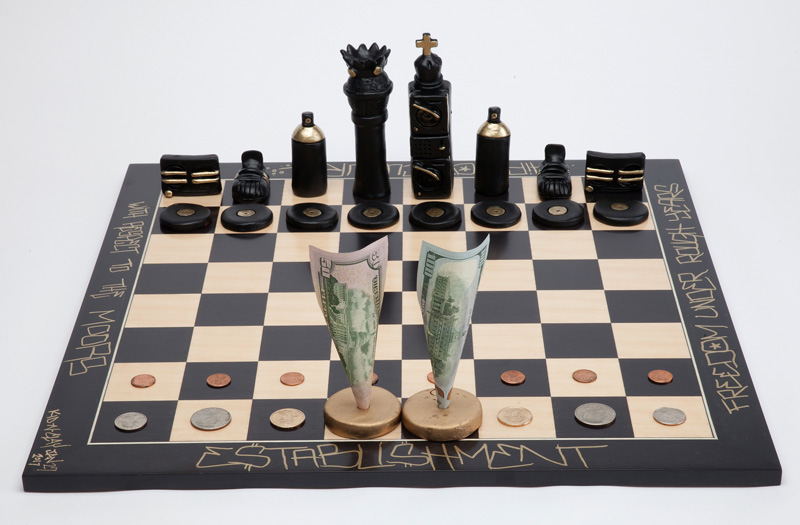
Nicholas Gates
Rules of Engagement, 2017
Painted ceramic, USD currency, and wood
Hip Hop King Size: 6 ⁄ in. Money King Size: 6 ¼ in.
Board: 21 ¼ X 21 ¼ in.
Collection of the World Chess Hall of Fame
Rules of Engagement explores the tensions between art and commerce. Specifically, Nicholas Gates is interested in whether money helps build or destroy a budding culture—if it helps provide stability to foster creativity, or encourages bland sameness. On one side of this set is the “establishment,” composed of different values of currency. Opposed to them are symbols of the four elements of hip hop: djing (king), mcing (queen), graffiti (bishop), and b-boying (knight). Boomboxes, which Gates views as the “sword and shield of hip hop,” are the rooks and records are the pawns. Gates acknowledges the Moorish history of chess through graffiti on the side of the board. He also inscribed FURY on the board, a reference to his stage name, which stands for “Freedom Under Rough Years.”
Gates has been sculpting since he was in high school and has a deep love of hip hop culture, both through his own experiences as a b-boy and his father and brother’s work as DJs. Sources as diverse as Michelangelo, graffiti, manga, and iconic hip hop album covers influence his work. Gates sees many similarities between the qualities needed to become a skilled chess player and those needed to navigate contemporary society as a young African American man, including determination, perseverance, patience, and an ability to anticipate how another might interpret your actions.

Meghan Grubb received her MFA in Art and Design from the University of Michigan in 2012 and her BA in History and Studio Art from Wellesley College in 2005. She makes works of sculpture and installation that explore the non-rational and intuitive responses of wonder and anxiety. Investigating what is at stake when we engage with the fringe of our conscious experience, Grubb focuses on the ways that we respond—both physically and emotionally—to precarious situations.
Grubb’s work draws on art and architecture, research into literature, perceptual psychology, optics, and the natural environment. Her practice generates new questions and strategies on interrupting the built environment, bending our expectations of physical space, and creating opportunities for psychological and conceptual vertigo. Grubb intends to leverage the uneasiness in the relationship between humans and the physical spaces we inhabit, making work that may prove at once playfully reassuring and profoundly disquieting.
Grubb’s exhibition record includes group and solo shows, collaborations, and site-specific installations. Her work has been exhibited internationally in Norway, Finland, Spain, and Thailand, and nationally. Selected exhibitions include: Appetite for Destruction, Wassaic Project, Wassaic, New York (2016); Chain Letter, Shoshana Wayne Gallery, Los Angeles (2011); Long Fall, Heaven Gallery, Chicago (2014); and Beacons, Urban Institute for Contemporary Art, Grand Rapids (2014). She has received numerous awards and grants, among them the American-Scandinavian Foundation Fellowship (2012-2013), Regional Arts Commission Artist Fellowship (2015), Creative Stimulus Award (2015), Alice C. Cole ’42 Award (2015), and has recently been nominated for the Joan Mitchell Foundation Painters and Sculptors Grant (2014) and the Joan Mitchell Foundation Emerging Artist Grant (2015 and 2016).
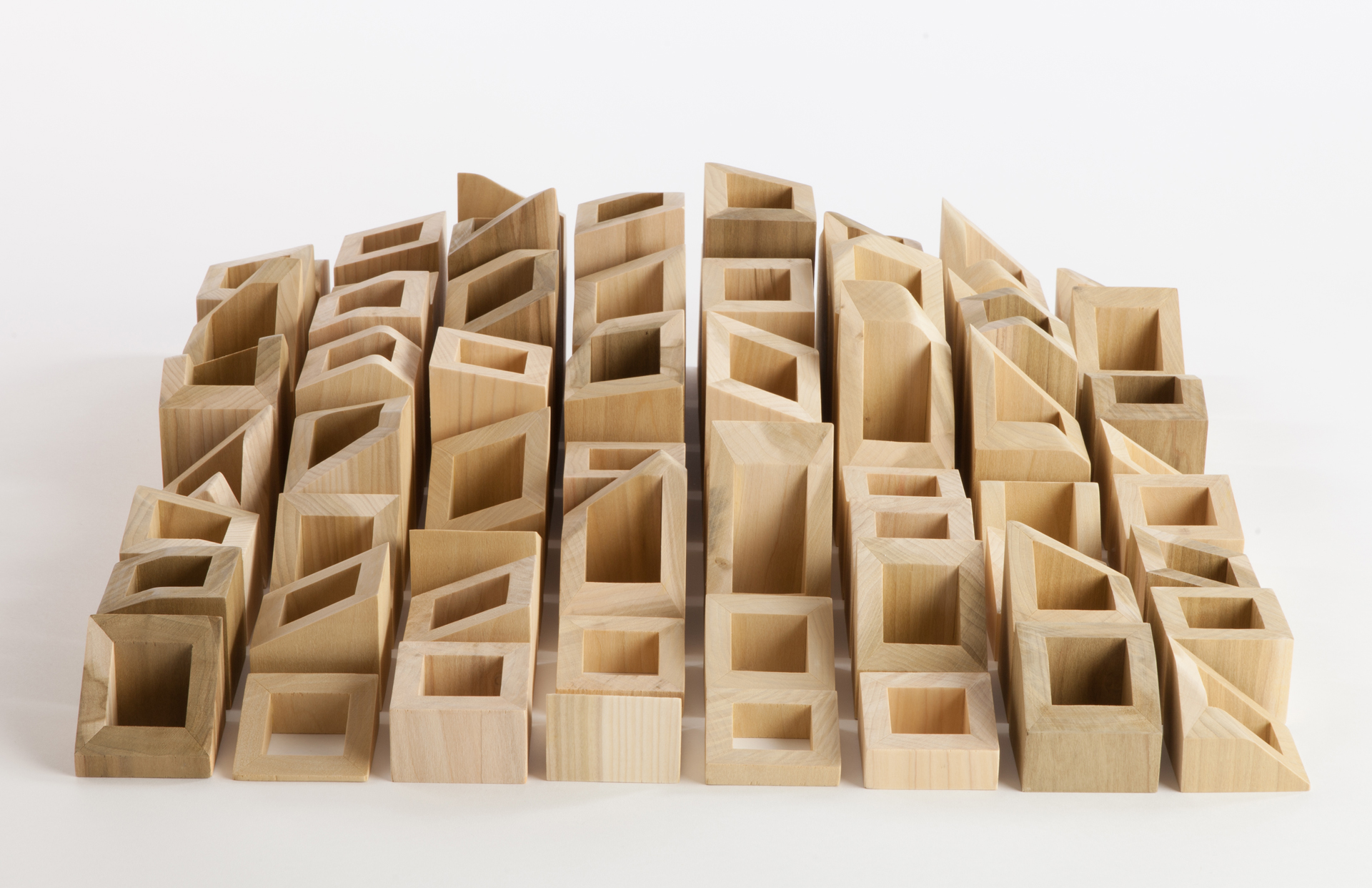
Meghan Grubb
Speculative Field, 2017
Poplar
King Size: 1 ½ in. Board: 5 ¾ x 23 x 23 in.
Collection of the World Chess Hall of Fame
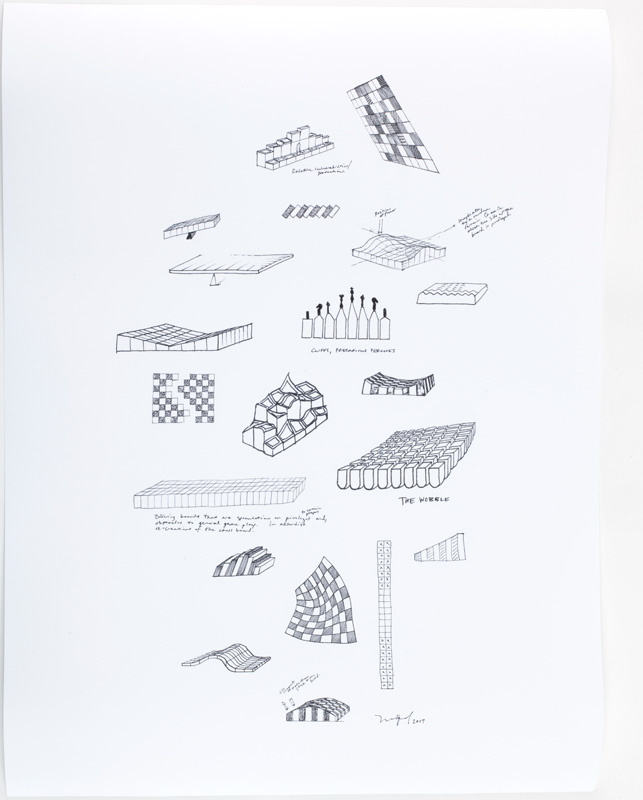
Meghan Grubb
Speculative Fields, 2017
Digital print
24 x 18 in.
Collection of the World Chess Hall of Fame
Speculative Field considers the physical space that chess pieces occupy and through which they move. The flatness and right angles of the traditional chessboard suggest a democratic, equal-access, unbiased field of play for the classic game of war. This straightforward setup contrasts with the complex conceptual landscapes of any real war—be it political, cyber, etc—that we may conceive of in the present day. Real spaces of conflict are rife with confusion and misdirection, barriers of privilege, bias, and various protections. In re-envisioning the chessboard, we can consider how the physical structure of the board might mimic a real conflict landscape—one that may undermine game play, advantage one player over another, or even render the game unplayable.
Developing from Meghan Grubb’s practice in interrupting built environments and bending expectations of physical space, the “speculative field” shown here expresses a modular board in which chess pieces might “hide” among the spaces of the board. This piece eliminates the black and white squares of the traditional board, instead offering changeable topographical features that add visual confusion to any human player who must navigate the playing field. The sculpture is accompanied by a digital print illustrating other imagined fields of combat that pose their own challenges to players.

Gregg Louis is a multidisciplinary artist who works in a wide range of media including painting, drawing, photography, sculpture, and video. He received his BFA from Missouri State University and his MFA from the School of Visual Arts in New York City. Louis’s work investigates ideas of belief, interpretation, and perception. He creates uncanny objects and images that rest on the blurry line between abstraction and representation. Often influenced by everyday objects and actions, Louis twists the mundane into strange and humorous deviations of its original form. His works playfully explore the patterns and perceptions of our daily lives.
Louis’s past solo exhibitions include: Likeness, Nohra Haime Gallery, New York (2015); Blind Spot, Hverfisgallerí, Reykjavík, Iceland (2015); and It, or the Something in the Lake, Hotel Maria Kapel, Hoorn, the Netherlands (2011 collaborative project). He has also participated in group exhibitions in the United States and abroad, such as: This One Is Smaller Than This One, Galerist, Istanbul, and Postmasters Gallery, New York (2016); Salon 94 x The Smile Face Museum, Frieze, London (2014); ArtBo, Bogota, Colombia (2014); Bibbidi-Bobbidi-Boo, Here Art Center, New York (2014); Videos on the Front, Interstate Projects, Brooklyn (2011); and Doing Easy, Los Caminos Gallery, Saint Louis (2011). In 2009, Louis was an artist-in-residence at the Skowhegan School of Painting and Sculpture. The New York Times, The Wall Street Journal, Sculpture Magazine, and several other prominent online blogs and journals have covered his work. He is represented by Nohra Haime Gallery, New York.
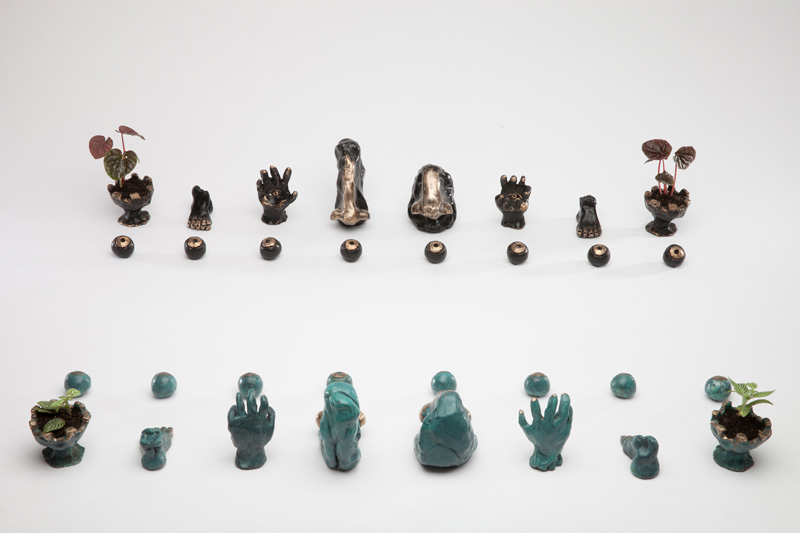
Gregg Louis
Untitled (Chess Set), 2017
Rubbed bronze and plants
King Size: 4 ½ in.
Collection of the World Chess Hall of Fame
Untitled (Chess Set) explores concepts of luck and superstition through a chess set with pieces representing body parts and castle-like towers. Inspired by Louis’s previous body of work, each individual piece is selectively polished to create the illusion that people have rubbed the artwork. For hundreds of years people have been rubbing parts of figural bronze sculptures—everything from Abraham Lincoln’s nose to Buddha’s belly. Louis is fascinated by the idea of a talisman or an object where someone can deposit their worries merely by touching it. This apotropaic observance, intended to ward away bad luck, may be practiced out of vague superstition and/or out of tradition.
In this set, the nose represents the king and queen, alluding to the long history of the shapes of noses symbolizing class or heritage. Louis also wanted to utilize symbols and icons of different times and cultures within his set. The Hamsa Hand, representing the bishop, is an Arabic sign of protection that represents blessings, power, and strength, and is seen as potent in deflecting the evil eye. The knights are represented by feet, which refer to Greek and Roman foot soldiers. The rooks are the most direct reference to the traditional Staunton chess set with their castle-like features. Louis views them as english gardens (hence the real plants growing in them), evocative of humans’ to control nature. The pawns are represented by eyes, symbolizing the idea of “I must see it to believe it.” Louis’s choice of symbols creates a tension between the perception of chess as a game of pure logic and the purported magical and superstitious imagery in the set.

Cellist Bjorn Ranheim was appointed to the Saint Louis Symphony in 2005 and is a member of the Sun Valley Summer Symphony in Idaho. He earned his Bachelor of Cello Performance at the Cleveland Institute of Music and currently lives in the heart of Saint Louis. Ranheim serves as Music Director for the World Chess Hall of Fame, curating the Monthly Music Series, which features all genres of music, as well as the Composers Spotlight Series, which presents members of the St. Louis Symphony performing chamber music by the foremost composers throughout history.
A committed advocate of contemporary solo and chamber music, Ranheim has given world-premier performances of works by the late Stephen Paulus, Paul Schoenfield, Steven Heitzig, Peter Martin, Stefan Freund, and William Beckstrand.
He has also toured extensively in the United States, Europe, and Central America and is highly visible throughout the Saint Louis region, presenting recitals, educational programs, and chamber music performances. On multiple occasions, he has performed as a soloist with the St. Louis Symphony and Colorado Music Festival. He has also appeared with the New World Symphony, Columbia Civic Orchestra, National Repertory Orchestra, and the Washington University Symphony Orchestra.
Seeking out new directions and partners in music making, Ranheim also collaborates with internationally known jazz musicians, sharing the stage and recording studio with Branford Marsalis, Christian McBride, Peter Martin, Jeremy Davenport, and Brian Owens. Ranheim is a founding member of The 442s, an acoustic string ensemble that pursues innovative, genre-defying music making and collaborations.

Adam Maness is a versatile multi-instrumentalist, songwriter, composer, and arranger. Born in Saint Louis, Missouri, Maness has performed around the globe with award-winning artists from a plethora of musical genres. Shortly after beginning his studies in jazz piano as a young man, he began performing in clubs around Saint Louis. In 2001, Maness moved to New York City to attend the acclaimed Jazz and Contemporary Music program at The New School University and was soon deeply immersed in the city’s jazz scene. In 2003, he moved home to Saint Louis and began playing with renowned vocalist Erin Bode.
In ten years, Maness has recorded six albums and traveled across America, Europe, Japan, and South Africa as Bode’s pianist, guitarist, and songwriting partner. In 2011, along with St. Louis Symphony musicians Bjorn Ranheim and Shawn Weil as well as bassist Syd Rodway, he helped found the acclaimed, genre-bending quartet, The 442s, for which Maness is the primary composer. In the summer of 2014, Maness was commissioned by Brian Owens to write an orchestral piece titled Divides that Bind for a unity concert in Ferguson, Missouri. In February 2015, the piece was reprised by the St. Louis Symphony Orchestra and IN UNISON Chorus, under the direction of Kevin Mcbeth, for their Black History Month concert at Powell Hall. The St. Louis Symphony Orchestra, The Metropolitan Orchestra of St. Louis, Peter Martin, Erin Bode, David Halen, Peter Henderson, Karin Bliznik, The Trombones of the St. Louis Symphony, Brian Owens, and Chamber Project St. Louis have performed his compositions and arrangements. Maness performs regularly around Saint Louis with his trio featuring bassist Bob DeBoo and drummer Montez Coleman.
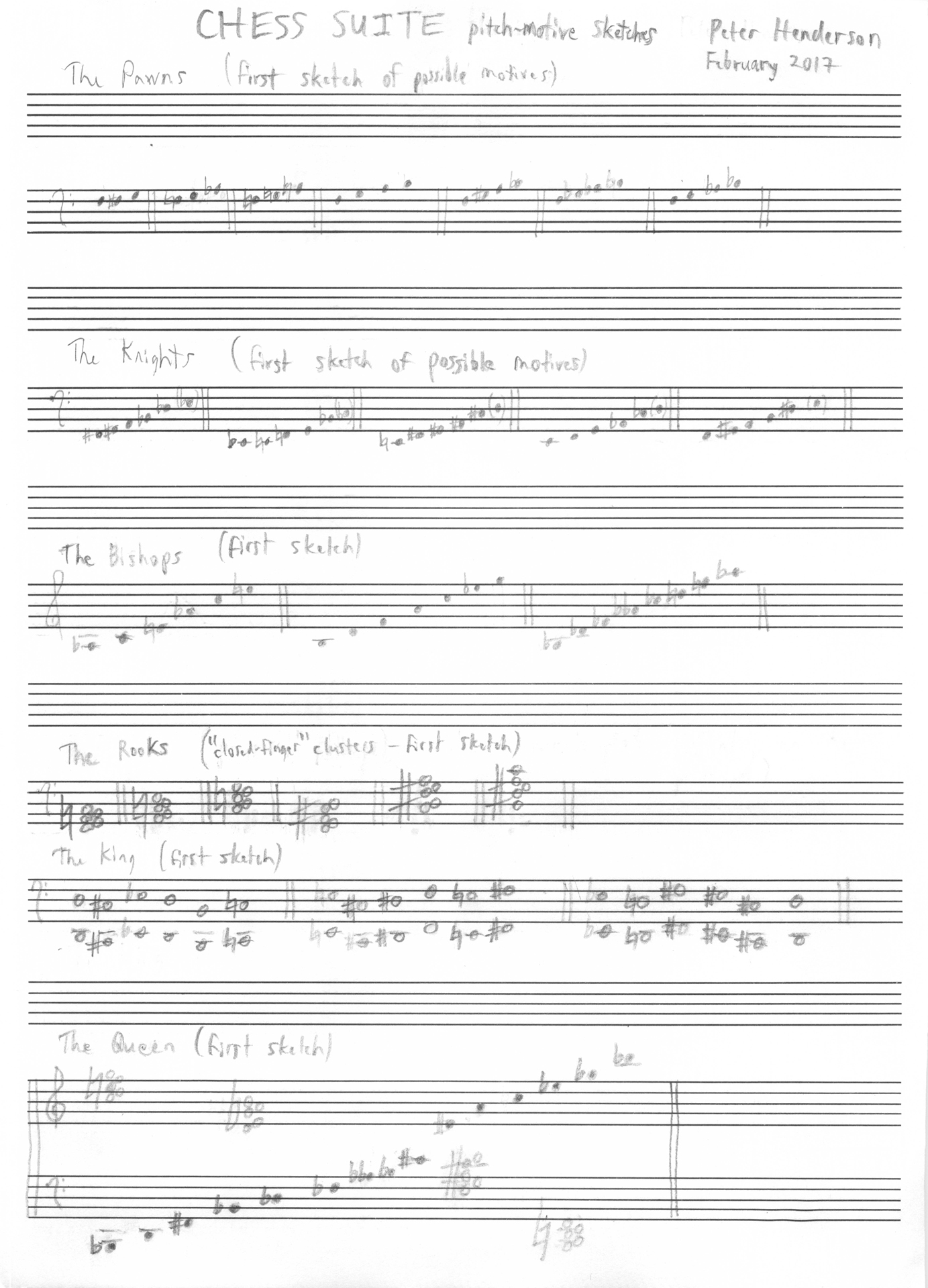
Bjorn Ranheim and Adam Maness with co-collaborators Christopher Stark and Peter Henderson
Chess Suite, 2017
Inkjet print on fine art rag paper
14 x 10 in.
Collection of the World Chess Hall of Fame
Composition courtesy of the artists
With co-collaborators Christopher Stark and Peter Henderson, Bjorn Ranheim and Adam Maness have created, produced and will participate in the performance of a concert event on September 20, 2017, as part of the World Chess Hall of Fame’s Monthly Music Series. It will celebrate the game of chess, the original The Imagery of Chess exhibition, and the culmination of The Imagery of Chess: Saint Louis Artists. The event will include performances of John Cage’s Chess Pieces and Vittorino Rieti’s Chess Serenade, as well as world premier performances of works composed for this exhibition by Maness, Stark, and Henderson.
Chess Suite for solo piano, 2017
Chess Suite is inspired by composer Peter Maness’s love for the game. Each piano piece within the suite will embody a chess piece, represented by musical motives and rhythms patterned after its movement on the board. Maness hopes that his suite will serve as a welcome introduction to non-traditional pitch materials for piano students. He is grateful to Bjorn Ranheim and the World Chess Hall of Fame (WCHOF) for the opportunity to compose this musical work, which will be premiered at the WCHOF on September 20, 2017.
The Pawns—The pawns will progress slowly and softly at first. Since they can only move forward on the chessboard, pawns will be confined to rising scale segments.
The Bishops—Bishops can flash quickly across the board along their diagonals. They will be represented by arpeggiated figurations (beginning on white or black keys—but never both simultaneously).
The Knights—The knights’ distinctive movement will be traced by “curlicues” that combine the pawns’ stepwise motion and the bishops’ skips. Knights’ unique ability to leap other pieces invites an elegant setting in dance rhythms.
The Rooks—Implacable and severe, rooks will be represented by ponderous, block-like clusters on the white and black keys.
The King—The king will enter as a kind of cantus firmus in octaves, in the piano’s baritone register. As in many games of chess, the king’s slow-moving melody will move “up the board” to higher registers as time goes on.
Advancing Pawns—At this point in the “game,” some pawns will have reached the sixth or seventh rank, making them very powerful! One pawn will achieve the eighth rank and be promoted to a queen.
The Queen—The queen’s unrivaled power will be shown in a combination of the rooks’ block-like clusters and the bishops’ flashing arpeggios. This texturally rich finale will be the culmination of the Chess Suite, which will conclude when the queen overwhelms the adversary’s king. Checkmate!
Sounding Strategies, 2017
The concept for this compositional collaboration arose from discussions on providing live music for the March 23rd The Imagery of Chess: Saint Louis Artists exhibition opening. Inspired by algorithmic generation of sound using data collected during chess tournaments, live matches will be played on DGT boards during the event while algorithms map that data onto musical parameters, which will then provide live ambient sound. Maness and Stark will blend this electronic music with instrumental music when shaping the data retroactively to compose a work for acoustic instruments. Though the data points will remain the same, electronic sounds that are played at the opening will be vastly different than those that come out at the premiere of the finished piece, which will be based on themes that come from the sonification of chess matches played during the opening event.
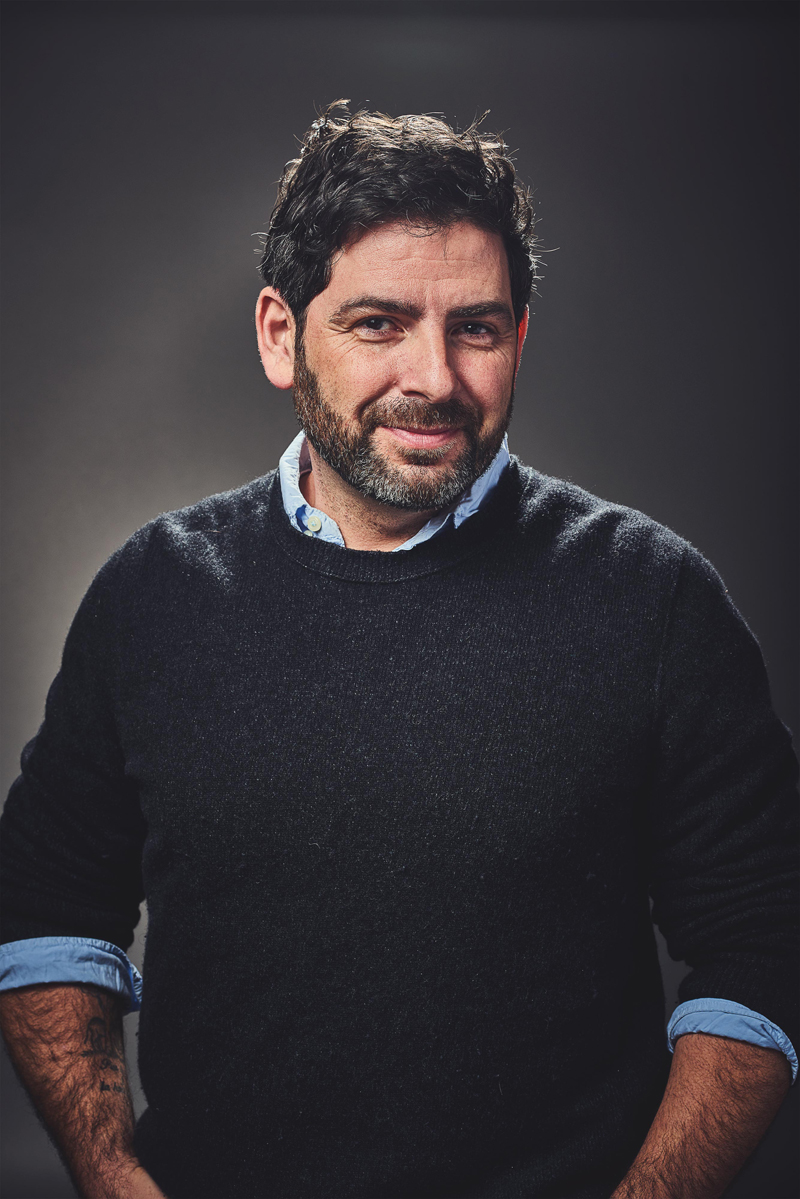
Peter Manion is a native Saint Louisan who returned to the city in 2000 after studying and living in Chicago, Illinois, and Louisville, Kentucky. Though he completed his studies at the School of the Art Institute of Chicago, Manion spent nearly ten years away from the art world focusing on other career paths and his role as a father. For the past six years, however, he has returned to his studio, as a full-time artist, creating and showing his work continuously with participation in numerous group exhibitions as well as solo shows, most recently at Houska Gallery in Saint Louis. Manion’s work blends elements of painting, drawing, sculpture, and performance. Concentrating on the idea and the process of creating art, his work has been evolving, challenging both him and his audience. Using an assortment of tools, techniques, and mediums, his work contains subtle abstract details and images built around a central form that frequently demands the viewer to ask “How is that done?”
Manion’s current practice has transitioned from painting to sculpture after a month-long residency in Spain, where he explored the visual influence of scale as it relates to the outside environment. These sculptures are the outset to a deeper study into the idea of what an art object and is and if an art object needs to be preserved or revealed. By constantly changing, the sculptures experience a lifespan with ephemeral qualities. This offers the viewer a chance to understand that art is meant for something more than to be acquired. It needs to live and change to be meaningful to our existence and to remind us of our own temporary place.
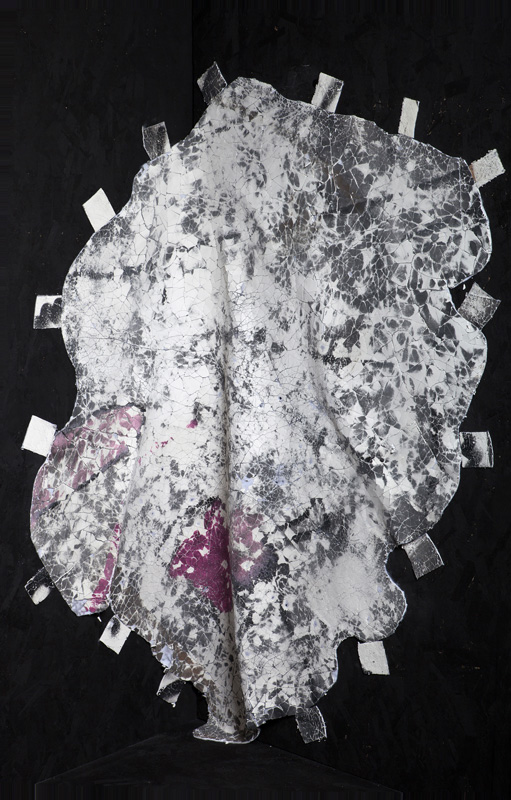
Peter Manion
Cosmic Zarathustra, 2017
Felt, plaster, and ink on stained MDF boards
96 x 48 ½ x 40 ½ in.
Collection of the World Chess Hall of Fame
Cosmic Zarathustra blends simple materials: felt, plaster, and paint. During Manion’s 2016 La Fragua art residency in Spain, he explored the idea of scale and performance in the natural world, discovering that he was limited in how he could alter the environment by way of displaying his pieces. He states, “I had a eureka moment when I realized that they [felt sculptures] could hang on their own without any assistance. It could, in a sense, defy gravity but it did not compromise the integrity. They could be placed and removed like stickers. The exciting part was that it still had the potential to succumb to the forces of gravity and fall, creating a whole new sculpture. That moment changed how I would ultimately see the possibilities moving forward.”
Julien Levy’s desire for artists to create chess pieces “more adequate to the role the figure has to play in the struggle” and “whose visual aspect would represent a clear incisive image to its inner conflicts” in the 1944 exhibition inspired Manion. In Cosmic Zarathustra, very literally, the struggle is for the piece to remain hanging on its own. The inner conflict is represented by the work as it relates to the viewer and to the artist. Manion writes that, “allowing the final outcome of its existence to be out of my control is the dance and the war.”
Manion was nine when his mother bought a Milton Bradley Electronic Grand Master chess set, an electronic game of chess with actual movable pieces, which is now part of the collection of the World Chess Hall of Fame. He spent hours working to outsmart the computer, learning in the process lessons about managing your ego, letting go of control, and gaining an understanding of oneself through competition. Acknowledging that the game can be a dance or a war depending on how your perspective translates to this work.

Nika Marble is an artist and composer residing in Saint Louis, Missouri. She earned her MA in Russian and Slavonic Studies at the University of Missouri, Columbia, and studied studio art at the Imperial Academy of Arts in St. Petersburg, Russia. Marble’s scholarship is multidisciplinary, treating photography and critical theory in Europe between World Wars I and II, while also maintaining a strong interest in modern Russian literature and art history. She is a classically trained pianist and violinist, and performs frequently with her collaborator Louis Wall in their avant-jazz outfit Marble//Wall Duo. They have played at a wide array of venues in the Saint Louis area, including the Kranzberg Arts Center, The Luminary, and KDHX. The Marble//Wall Duo’s music is an exercise in improvisation and collaboration, and seeks to present musical thought as an urgent reaction to the challenges of navigating a complex world.
Marble’s collages and paintings explore uncanny collisions between the conscious and unconscious self, challenging the viewer to engage with the tension and dissonance between private and presented identities. She is fascinated by collage as a medium for its material accessibility, and for its potential to reflect an environment and context through its source materials. Identity is a recurrent theme in her work. The figures in her collages seek to achieve full forms by cobbling together attributes from a wide variety of sources, creating a chimerical pastiche that utilizes a diverse and unsettling sum of forms and experiences to render a whole self.
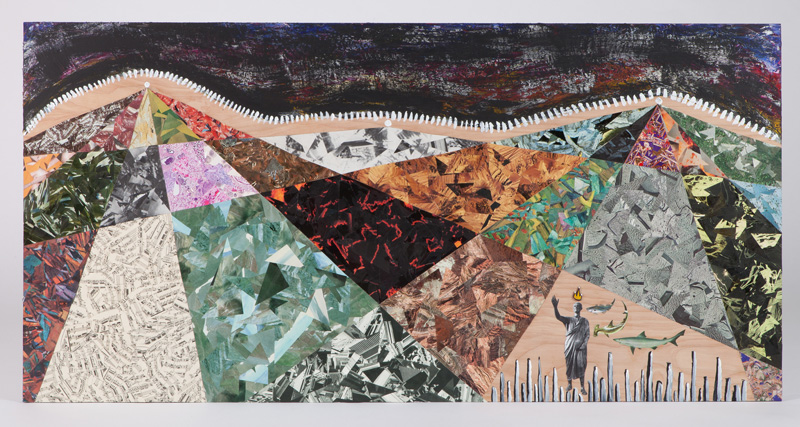
Nika Marble
king for a day // fool for a lifetime, 2017
Acrylic and paper on wood panel
24 x 48 in.
Collection of the World Chess Hall of Fame
King for a day // fool for a lifetime depicts a lone male figure trapped within a single square on a vast, empty grid. Sharks circle as he seeks rescue (or perhaps shouts a decree across the empty landscape). This man may be a regal figure but without his court and army, a gruesome end awaits. In chess, the king is often regarded as the most vital piece on the board, and the game revolves around elaborate strategies to protect him or to make escape impossible for the opponent’s monarch. By utilizing imagery of isolation and helplessness, Marble invites the viewer to challenge the notion of the king as the key figure in the game of chess.
Many pieces in the 1944 The Imagery of Chess exhibition were informed by the traumatic events of World War II and the subsequent resettling and reclamation of identity that many artists had to grapple with in its wake. Much like the original exhibition, this reimagining takes place during tumultuous political times, when identity politics and power structures collide in urgent and often violent manners. King for a day // fool for a lifetime, which focuses on a single diminutive figure, destabilizes notions of power and efficacy being vested in one agent.
The image of the chessboard is a collage of materials sourced from books scavenged in South City, Saint Louis. Marble received some as gifts from friends and collected others from abandoned buildings, estates, or thrift stores. Each square on the board is created from a single unique image sourced from a different location and represents the pastiche of experiences that make up the fabric of our day to day lives. The fragmented nature of what was once a whole image adds another level of isolation and fragmentation to the royal figure’s dilemma.
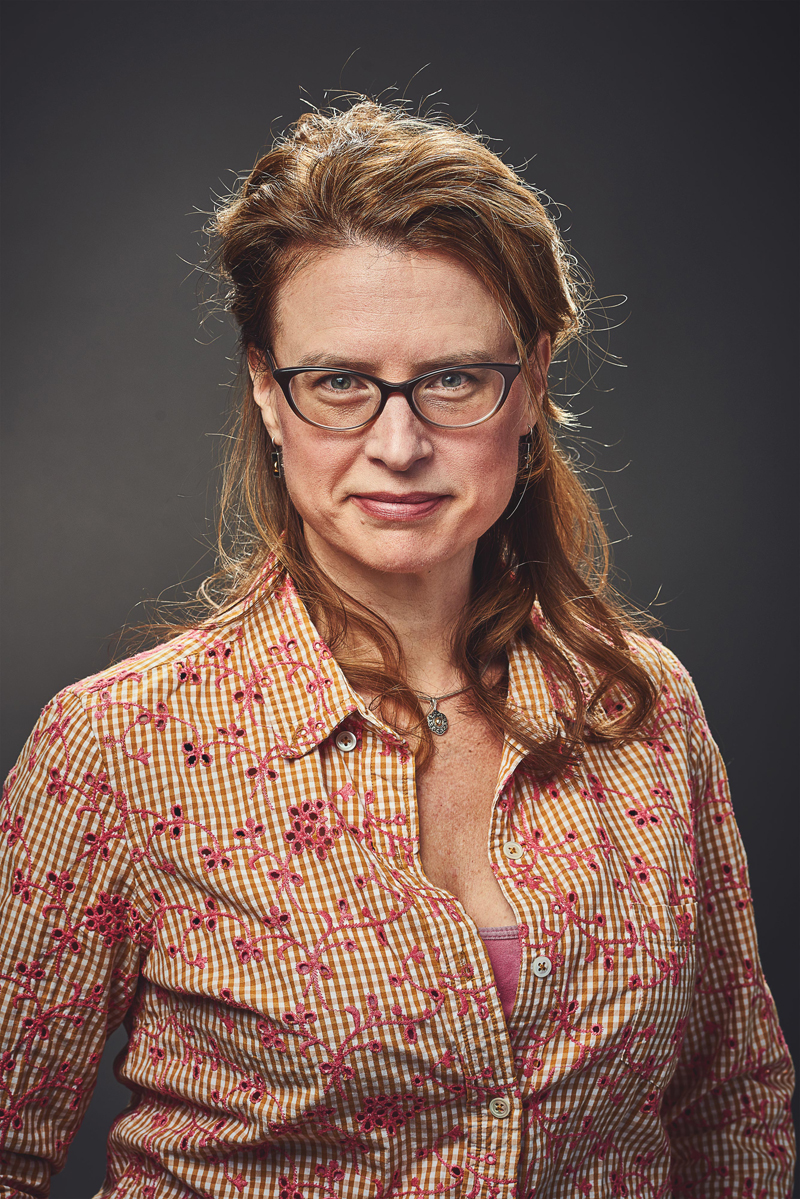
Adrienne Outlaw is a socially engaged artist whose work addresses issues of individual and communal health, especially in such areas as neuroethics and bioethics. Taking inspiration from consumer driven changes in food and drug policies, her goal is to create experiences in which viewers can imagine solutions and start a sea change. She holds a BFA from the School of the Art Institute of Chicago and a Master of Liberal Arts and Science degree from Vanderbilt University.
Outlaw has exhibited at galleries and museums across the United States and abroad in Italy, Hong Kong, South Korea, and Nigeria. Recent solo exhibitions include: Slices, University of Wyoming Visual Art Gallery, Laramie (2016); Spun: New Work by Adrienne Outlaw, Low Gallery, San Diego (2015); and Witch’s Brew, Whitespace Gallery, Atlanta (2014). She has also participated in a number of group exhibitions at venues including: the Parthenon Museum and Centennial Park, Nashville; Museum of the Shenandoah Valley, Winchester, Virginia; The Wright Museum of Art, Beloit, Wisconsin; MASS MOCA, North Adams, Massachusetts; Islip Art Museum, East Islip, New York; Krannert Art Museum and Kinkead Pavilion, Champaign, Illinois; Customs House Museum and Cultural Center, Clarksville, Tennessee; Art Museum of the University of Memphis; Fort Collins Museum of Contemporary Art, Fort Collins, Colorado; Frist Center for the Visual Arts, Nashville; Mobile Museum of Art, Mobile, Alabama; Cheekwood Botanical Gardens and Museum of Art, Nashville; and the Tennessee State Museum, Nashville.
A dozen exhibition catalogs and three art books feature Outlaw’s work, which has been positively reviewed in Art in America, Sculpture, Art Papers, and World Sculpture News. Additionally, she is the recipient of grants, awards, and fellowships from such organizations as the National Endowment for the Arts, The Andy Warhol Foundation for the Visual Arts, and the Elizabeth Firestone Graham Foundation. The U.S. Embassy in Nigeria, the Public Library of Davidson County, and Vanderbilt University hold her artwork in their collections.
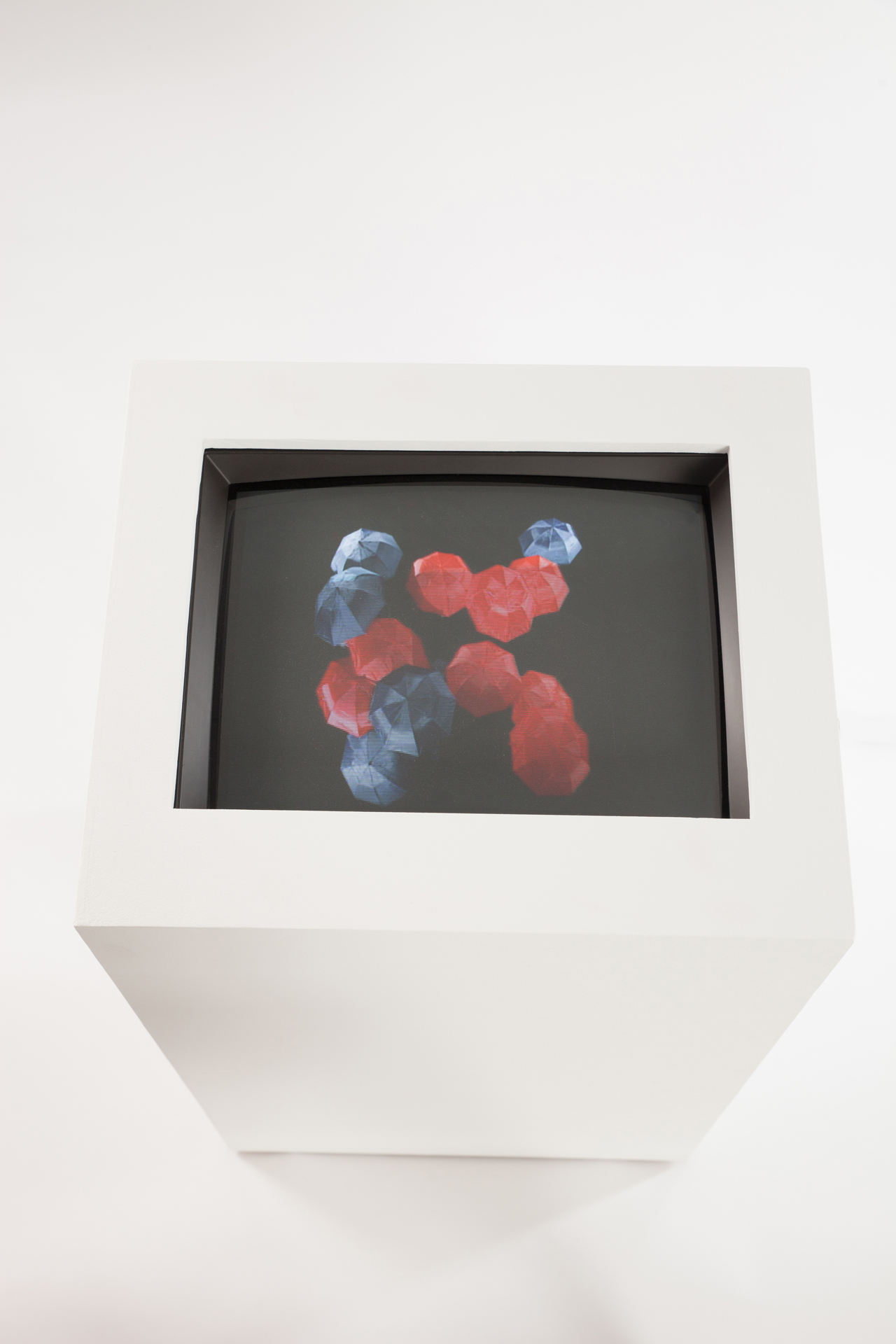
Adrienne Outlaw
ReSolve, 2017
Video on monitor with sound
2 minutes and 40 seconds
Sound design by Kyle Baker
Collection of the World Chess Hall of Fame
On February 1, 2017, 32 people gathered in artist Adrienne Outlaw’s studio to play a human game of chess in an effort to practice the art of respectful engagement, which emphasizes communicating with and listening to others in a respectful manner. Participants reenacted moves from the game played by Grandmasters Garry Kasparov and Judit Polgar in the 2002 Russia vs. the Rest of the World tournament. Polgar defeated Kasparov, marking the first time the highest-ranking female player in the world had defeated the highest-ranking male player.
For the moves and mindset of the performance, the players—with guidance from a yogini—drew upon basic tenets of yoga. Like chess, yoga requires focus, skill, and practice, yet welcomes all beginners. The players divided into teams of red and blue to represent various allegiances. Each person held an umbrella, which served as a symbol of protection and an emblem of dignity. Forced onto a small board and jostling for position with umbrellas held aloft, the players had to help each other navigate their moves and die with dignity. The resulting video, inspired by the work of Dadaist and Surrealist artists, reveals how unity and understanding may resolve chaos.
As part of the project, players from diverse backgrounds acquainted themselves with others they may never have had the opportunity to meet. Players, all of whom contributed to this piece, include: Maggie Abbott, Jenna Bauer, John and Marnie Bermingham, Mathijs Bicknese, Elena Canovas, Judy Child, Brady Decker, Debora Dobson, Brian Flowers, Daniel Foust, Lauren Franklin, Ilango Gurusamy, Brandon Hentze, Izaiah Johnson, Zeno Lavagnino, Kate Lilly, Christy Lin, Peter Manion, Shanan Manka, Meridith McKinley, Brittany Neier, Julie Preuss, Ben Simon, Jeff Sjerven, Leo and Paul Taghert, Lauren Tracy, Alessandro Ustione, Lynn Valeri, Alison Warren, and Mark Zimmerman.
Special contributors include Christy Lin, Shawn Klein, Patricia Joye, David Piston, Kyle Baker, Yoga in Demun, as well as the staff at the World Chess Hall of Fame.
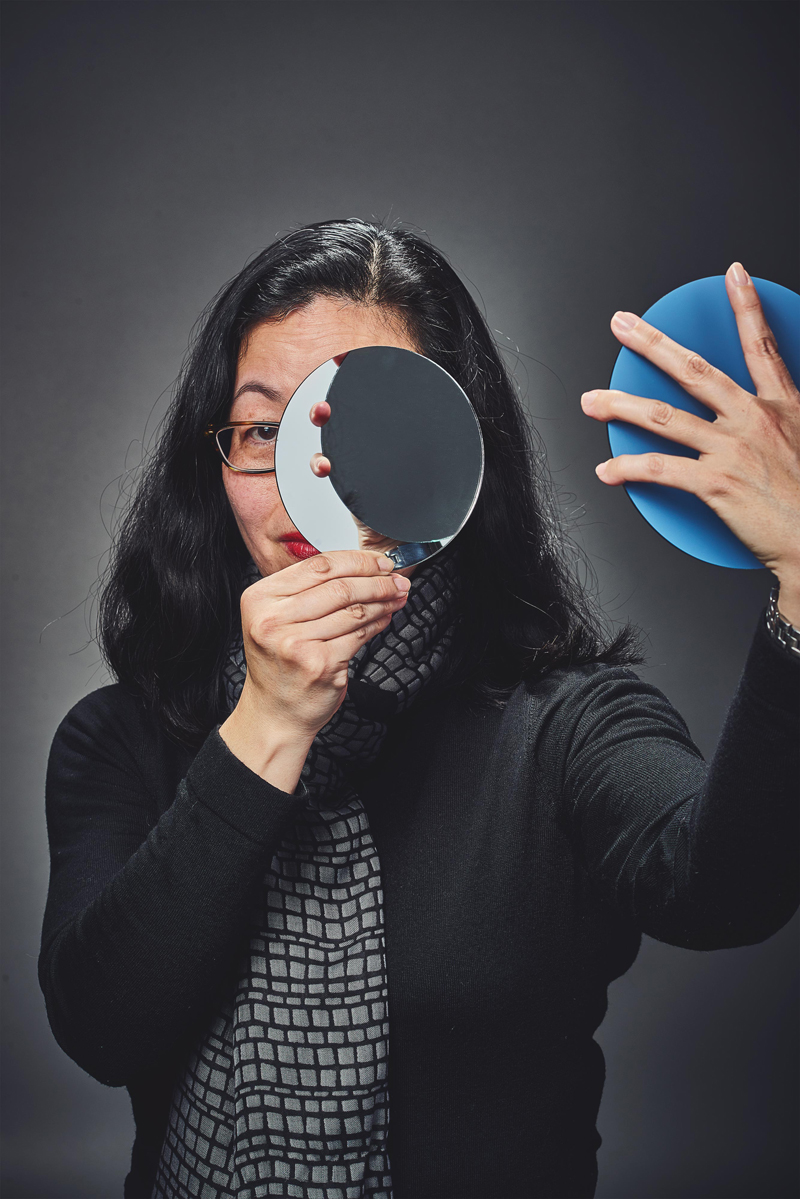
Yuko Suga studied metalsmithing with Heikki Seppa at Washington University in St. Louis, where she received an Intense Minor in Metals and a Master of Science degree in Occupational Therapy. She is involved in community-based programs as both a therapist and an artist, working with diverse groups of individuals in a variety of settings. Suga’s experiences contribute to an ever-expanding source of inspiration and modalities of creative expression. Her work is a reflection of the relationships between line, form, function, and process and is often inspired by events and experiences in the community and environment. By taking a single idea and bringing together related concepts and adding layers to it before deconstructing them into simple, minimalist terms, it allows the viewer (or in the case of jewelry, the wearer) to develop his or her own relationship with and personal meaning in Suga’s work.
In her role as a therapist, Suga investigates and identifies patterns of movements and behaviors that may indicate if an individual has specific concerns in learning and function, and works to develop effective strategies to facilitate learning opportunities and comprehensive skill building. Similarly, through her art, she contemplates patterns of issues and concerns impacting our communities and hopes to inspire the viewer to contemplate them as well through visual representation.
While teaching at Craft Alliance Center of Art + Design, Suga’s interests have expanded to include exploring the application of techniques used in one medium into other media. She is currently a faculty member at the Craft Alliance Center of Art + Design in Saint Louis in both metals and glass, and co-chair of the glass studio, where she has taught for over ten years. Suga exhibits her work in metals and glass both in the Saint Louis region and nationally. Most recently, the World Chess Hall of Fame showed her work Checkmate: Prototype I as part of its exhibition Ladies’ Knight: A Female Perspective on Chess (2016).
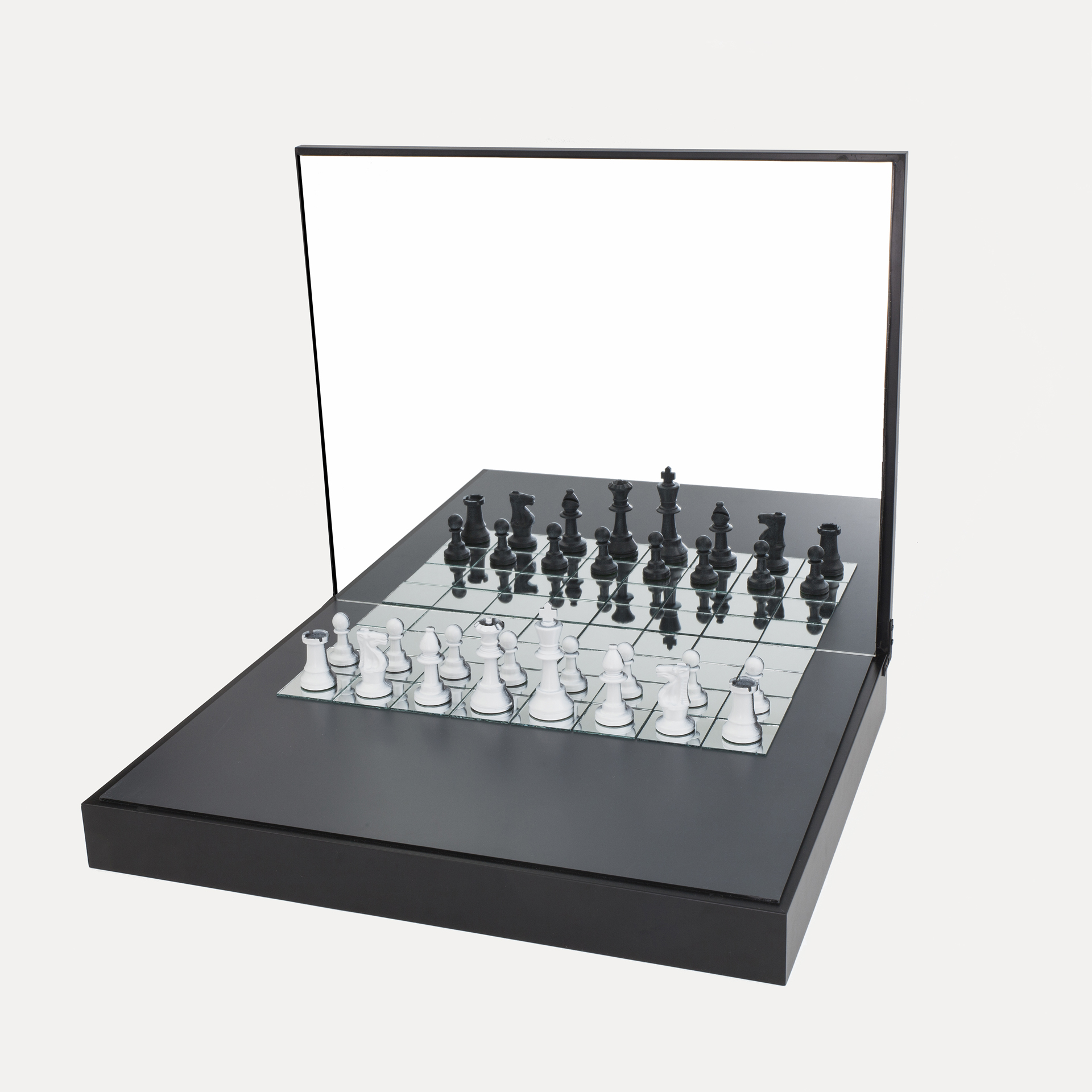
Yuko Suga
Image Re: In Glass, 2017
Glass, wood, plastic, and acrylic
King Size: 4 in.
Board: 19 x 17 ¼ x 21 ¼ in.
Collection of the World Chess Hall of Fame
Image Re: In Glass presents a chess set that, upon first glance, is literally one-sided. Progress in the game is constrained by the form of the set, which is comprised of 16 pieces and half a board. In this work, Yuko Suga positions the viewer, whose own reflection is visible in the vanity mirror, as his or her own greatest competitor. The game of chess involves interaction, each move a conscious decision based on the study of one’s opponent, an anticipation of his or her moves. Here, Suga shows that true competition is competing with oneself, and to know one’s opponent is to know yourself. The skill of looking within yourself and the ability to take on the perspective of another give opportunities for finding commonalities and cohesion.
Chess’s structure and rules often lead the game to be used as a representation of two opposing sides and conflict. As several artists in the original The Imagery of Chess exhibition incorporated themes relating to current events and social influences into their work, Suga’s work also explores current events and issues in our communities.
Each piece is both white and black, with gradation between the two. The pieces sit on separate mirrors and look and function differently. As powerful as one piece may be, its strength and value lie in how it can move with, or as part of the set. The platform for the board is the back of a mirror, one of two sides that may not often be seen. The spacing between the squares is flexible, and may be greater, smaller, angled, or even absent; however, to function as part of the chessboard, they must relate to one another. To develop into a community that is able to identify as “we”, there is a need for individual and community introspection as well as reflection.

Adrian Octavius Walker was born and raised in North Saint Louis and received his BA in Sociology with a certificate in photography and Women’s and Gender studies from the University of Missouri St. Louis in 2010. Walker now often photographs the mundane areas of the west and east sides of his current home city Oakland, California, where he works as an assistant editor on the entertainment community team for VSCO. Always curious, Walker also creates sensitive portraits based on his studies human interactions in intense environments. The work of black women photographers including Latoya Ruby Frazier, Carrie Mae Weems, Deana Lawson, and Deborah Willis Thomas, as well as his investigations of the black body and dynamics of the black family inspire his current work. This includes the 2016 mixed-media installation Living Room, which was curated by his wife Morgan H. Walker.
In 2015, Walker self-published the book My Lens, Our Ferguson, a documentation of the Ferguson, Missouri, protests that was shortlisted for a Paris Photo-Aperture First PhotoBook award. Images from that book were featured in a solo exhibition last year at the University of Alabama and in five group exhibitions internationally. The same year, Walker offered his insight into what it is like to grow up in North Saint Louis in an episode of Vice’s Abandoned, which aired in 2016. His work has been included in a variety of solo and group exhibitions including Black On Film, Creative Campus at The University of Alabama, Tuscaloosa, Alabama (2016); Dandy Lion, Brighton Photo Biennial, Brighton, England (2016); Black Mail 2, Space 236, San Francisco, California (2016); Common Sense(s), The Center for Photography at Woodstock, Woodstock, New York (2016); Paris Photo-Aperture Photobook Awards 2015, Huis Marseille, Museum of Photography, Amsterdam, the Netherlands (2015); and Street Beautification (a special installation as part of the exhibition Living Like Kings: The Unexpected Collision of Chess and Hip Hop), World Chess Hall of Fame, Saint Louis (2014).
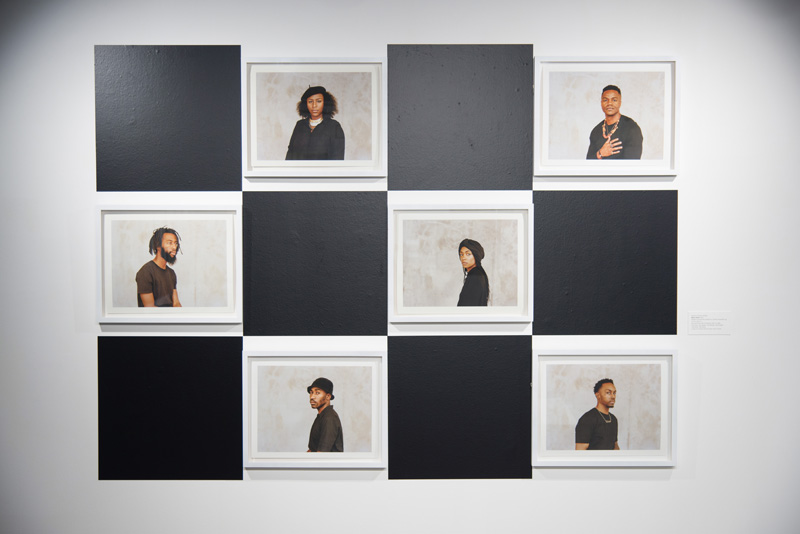
Adrian Octavius Walker
Black Rank, 2017
Medium format film printed on arches aquarelle rag
14 ½ x 18 ½ in.
Pictured from left to right, top to bottom: The King, The Queen, The Bishop, The Knight, The Rook, The Pawn
Collection of the World Chess Hall of Fame
In Black Rank, photographer Adrian Walker reimagines each chess piece as a member of the black family unit, each with his or her own role. The figures protect each other, make sacrifices, and lead others to move forward. Every piece is crucial to gains and wins in life. Five friends the photographer met after his December 2015 move to Oakland, California, represent the pieces. They are photographed wearing black before a simple background. The title of this work is a play on the term back rank, which refers to where the player sets up his major pieces.
Walker sees this series as a constant reminder that the photographer’s family will expand and evolve over time. The family into which he was born will remain the one most instrumental to his own identity, while new additions to his family unit will he creates on his own will be the ones instrumental to his growth. The final image in the series is an emotional display of the photographer as he transitions from player to pawn.
Artwork photography by Michael DeFilippo
Portrait photography by Matt Kile
Press
7/31/2017: The Nine Network — The Imagery of Chess: Saint Louis Artists (video)
6/1/2017: All the Art — Summer 2017
3/23/2017: Press Release
Downloads
